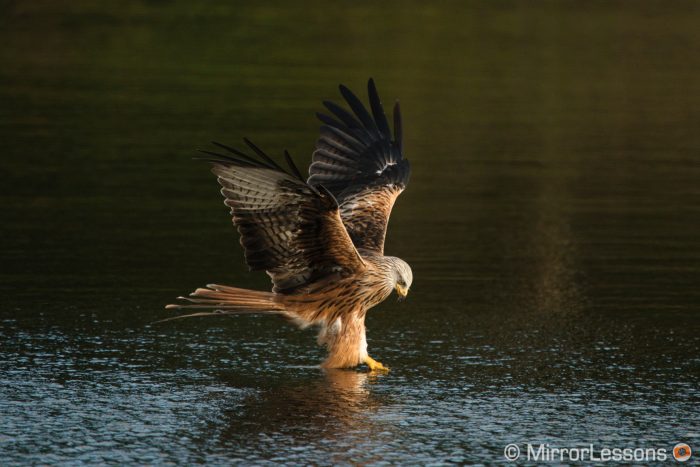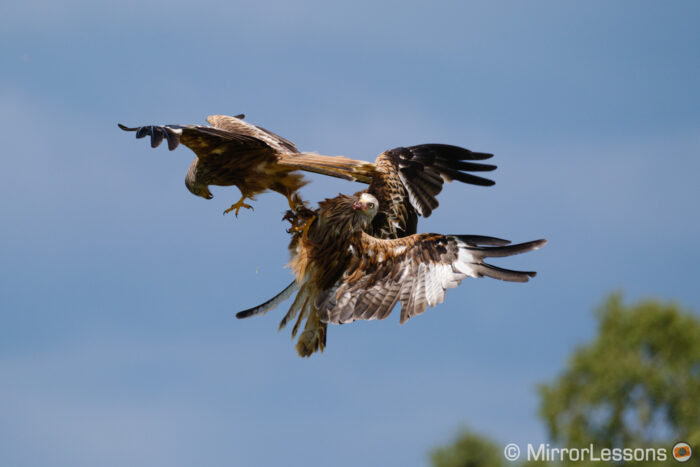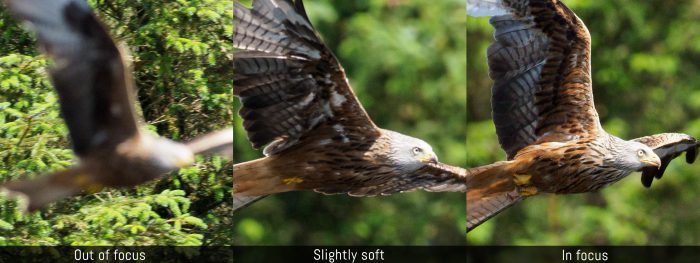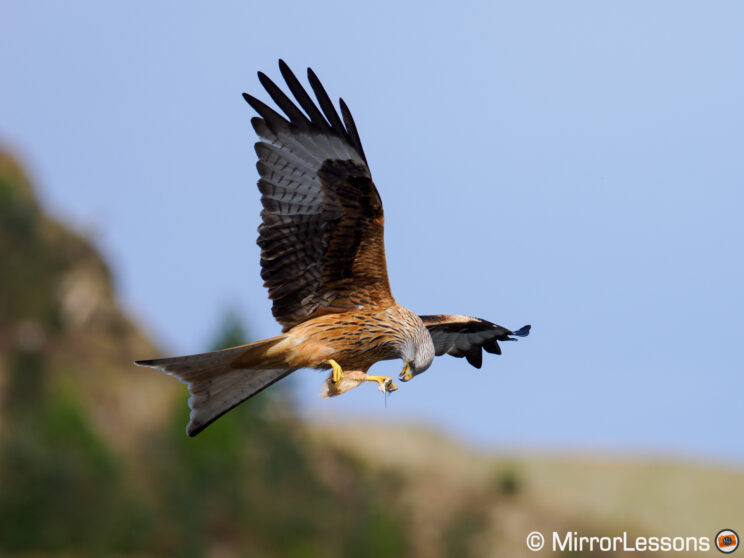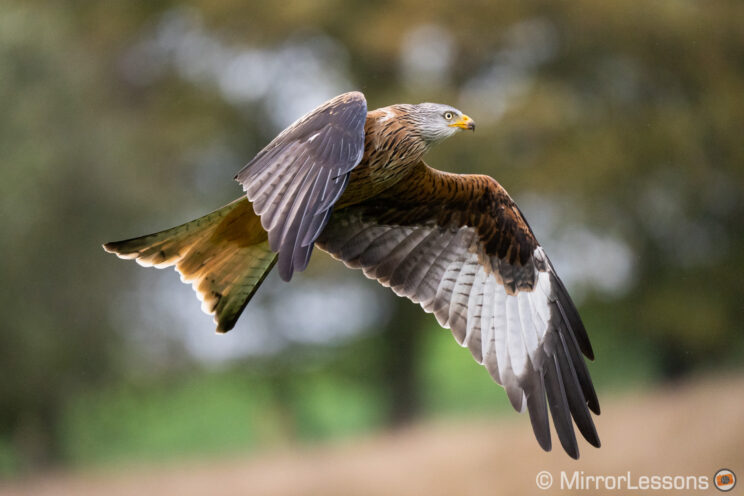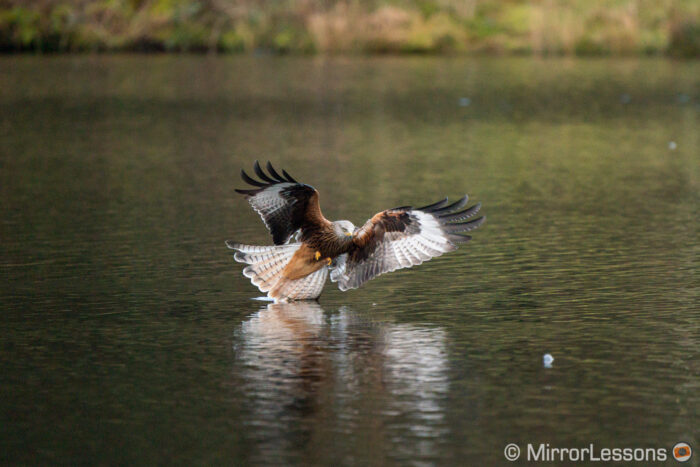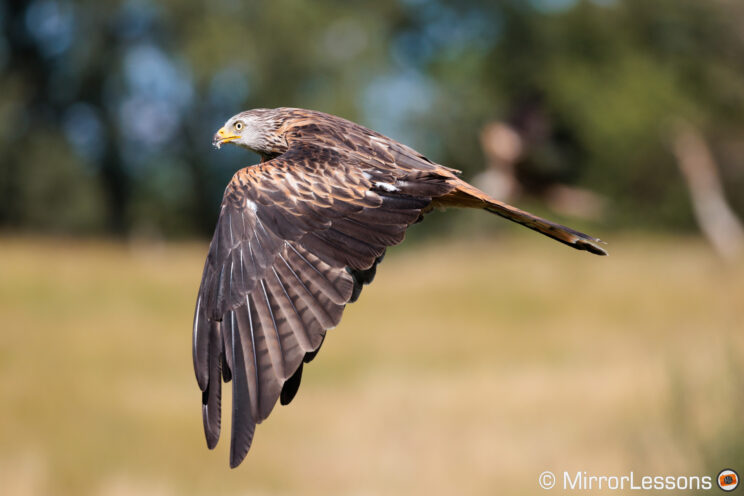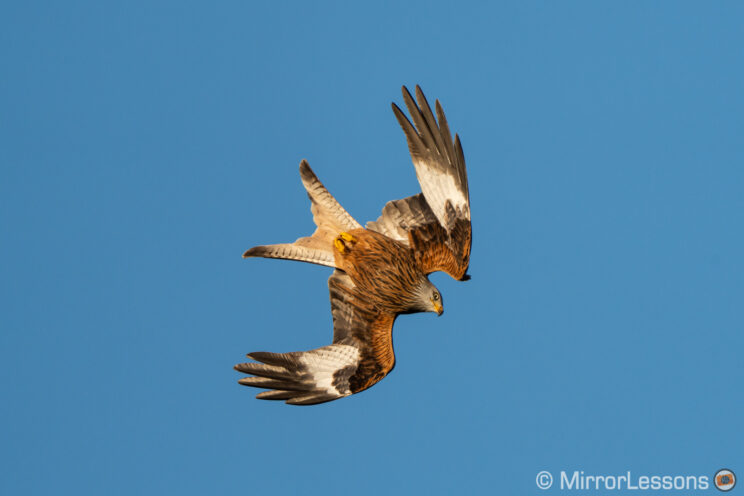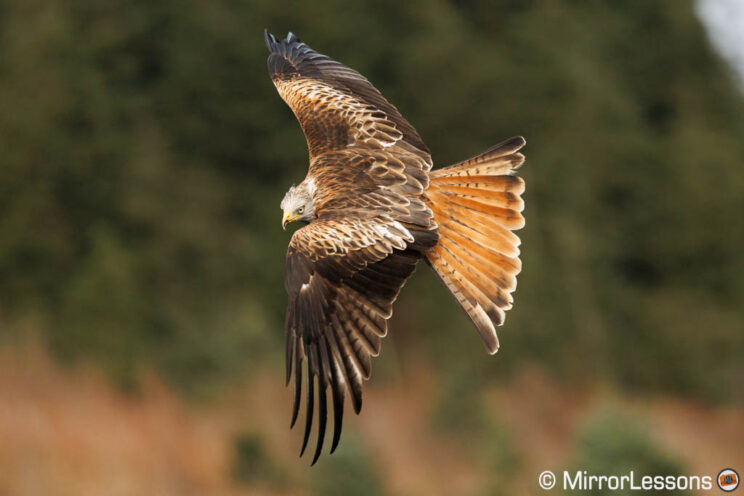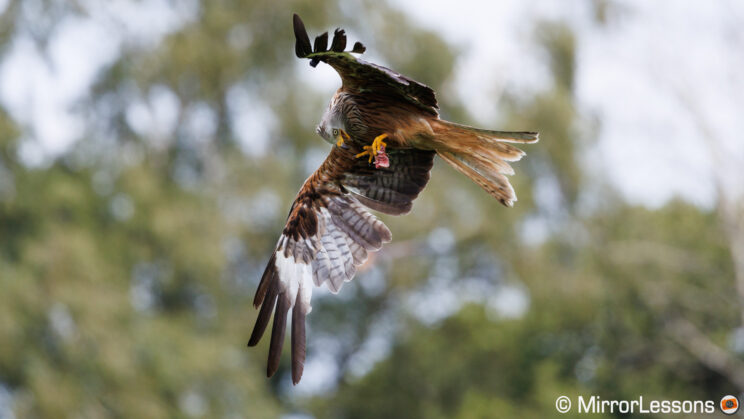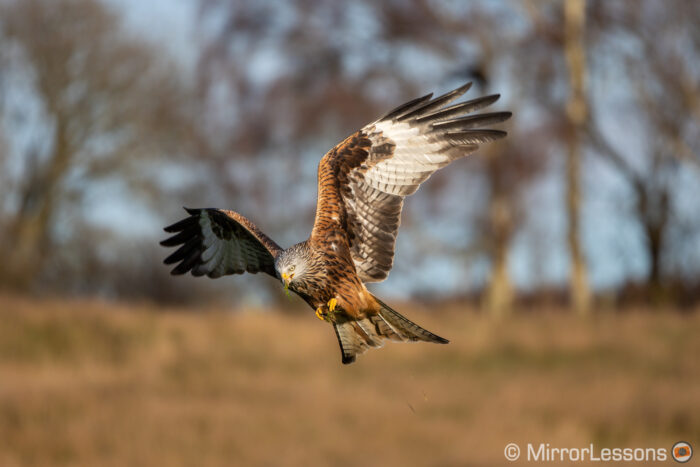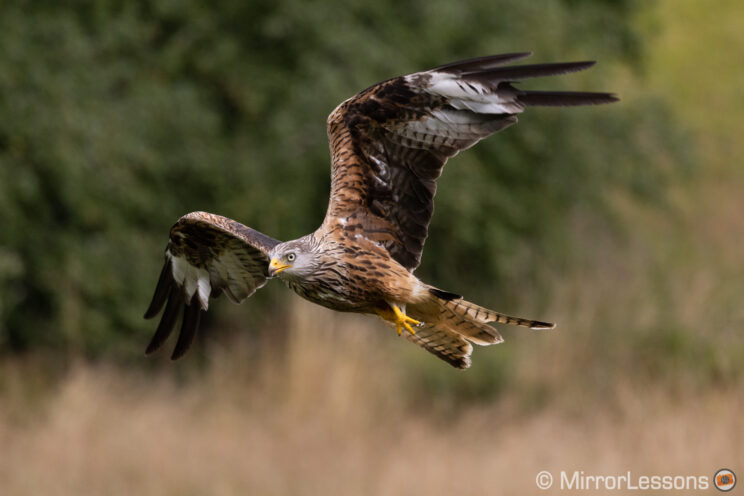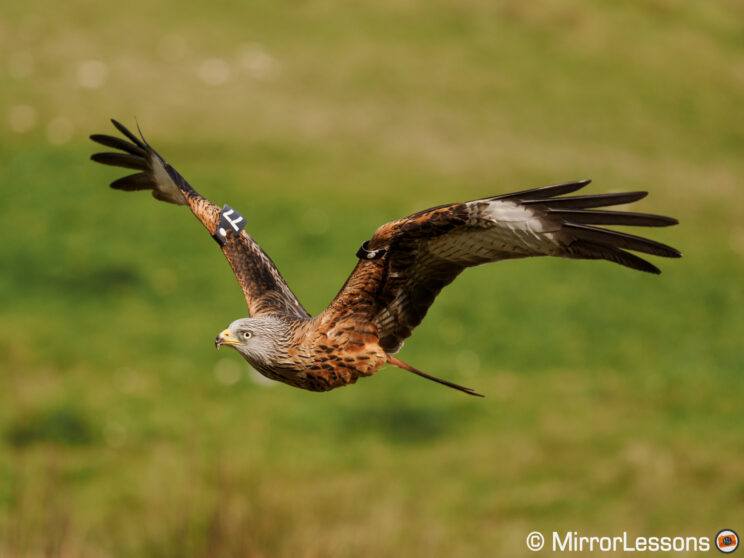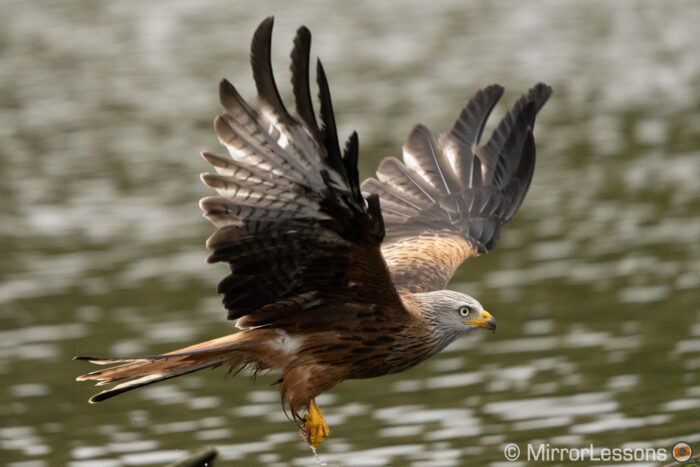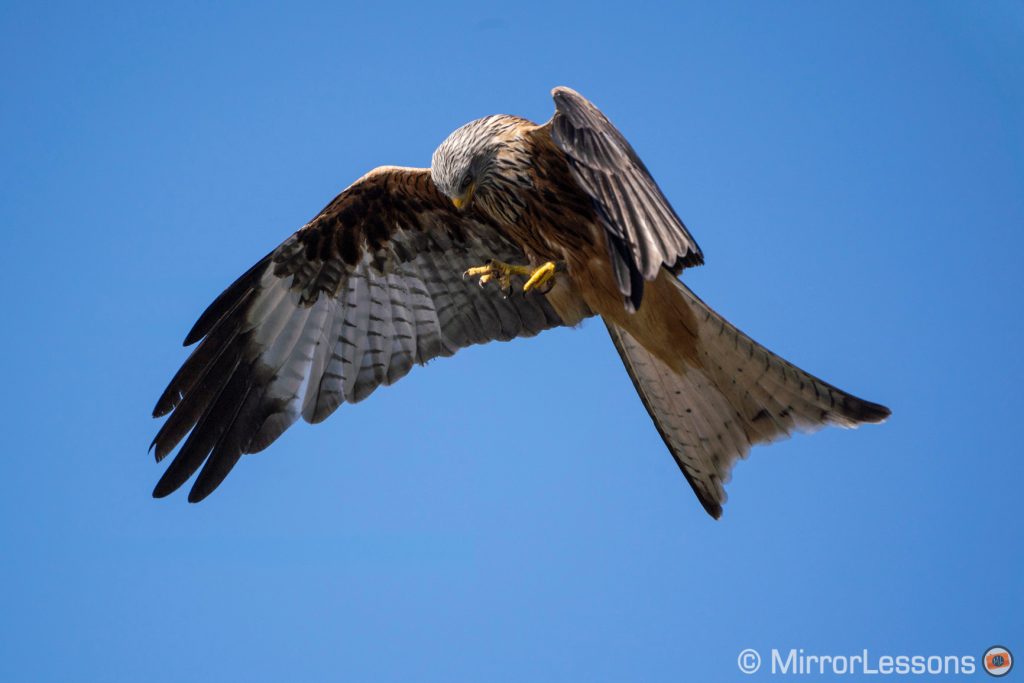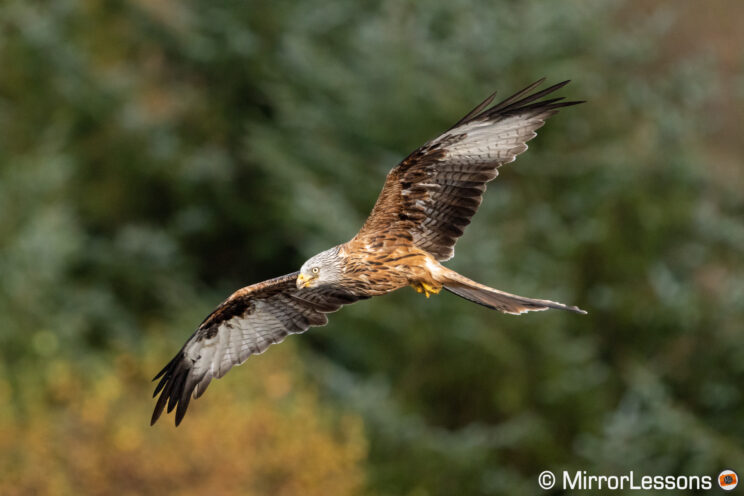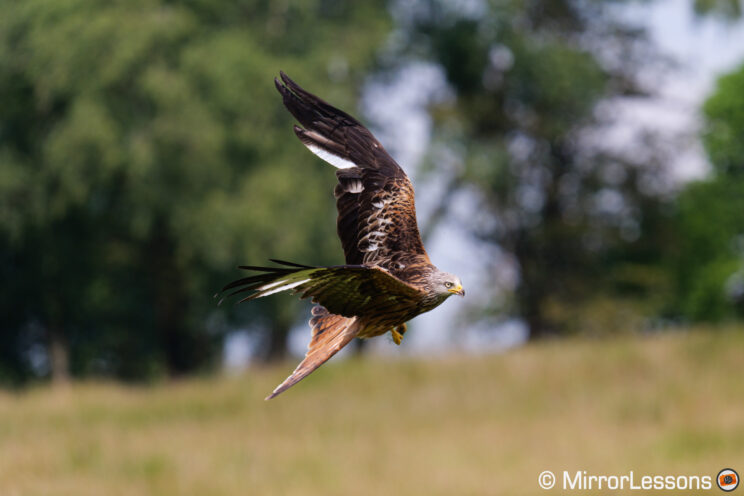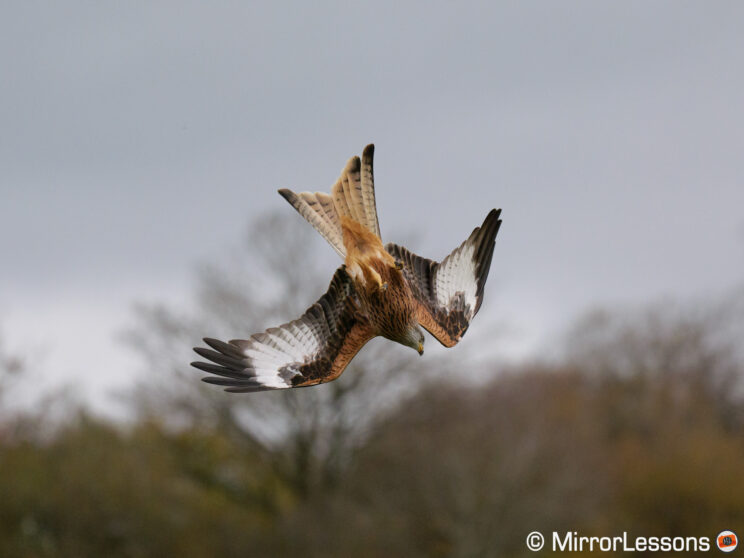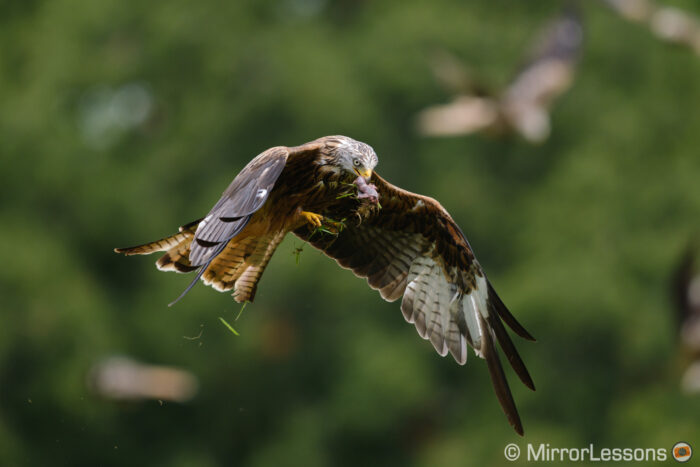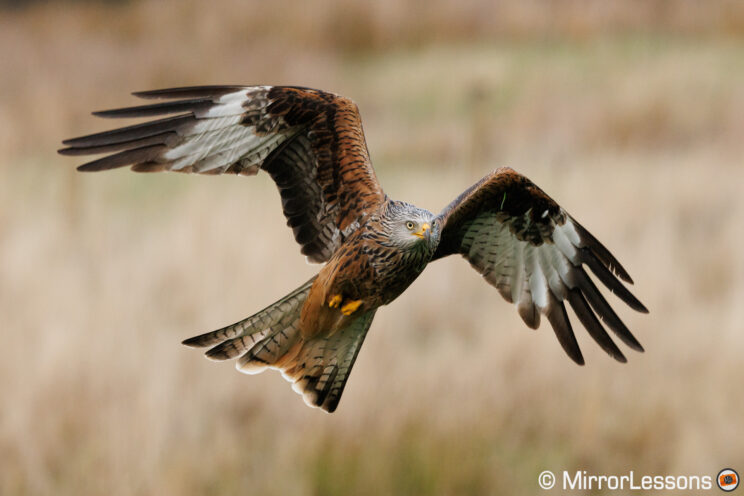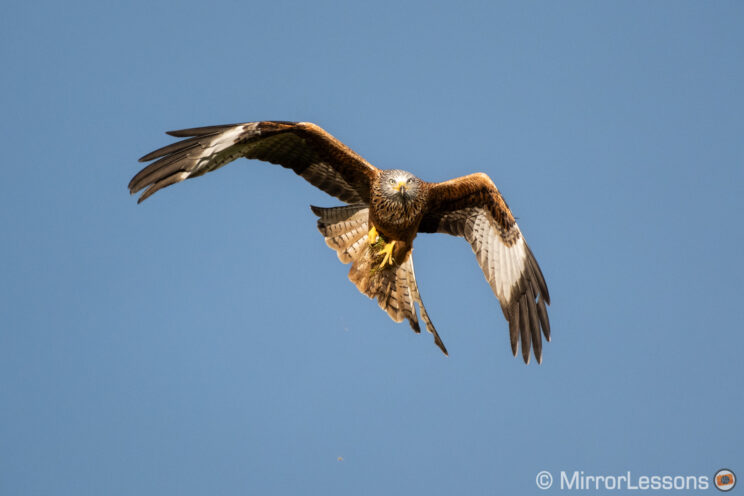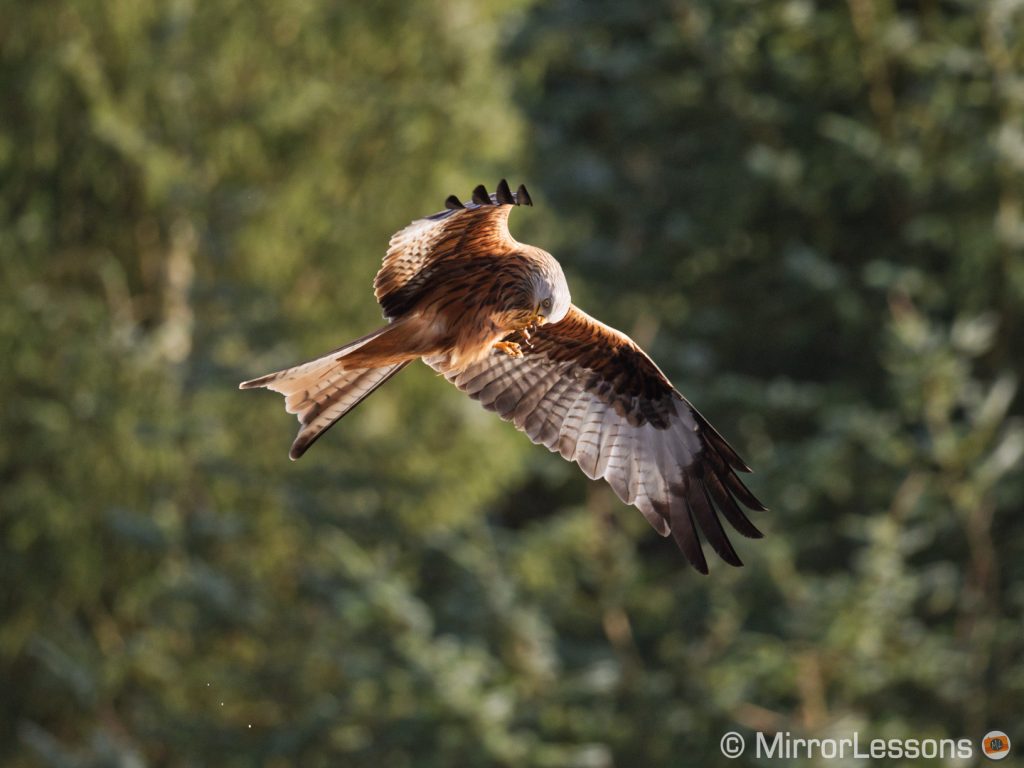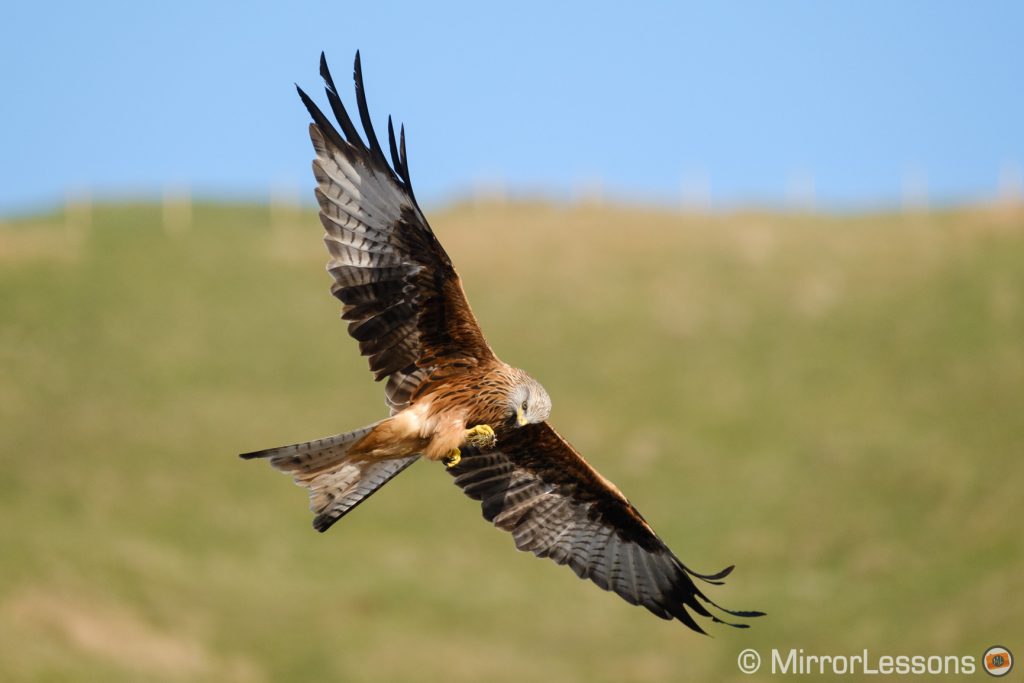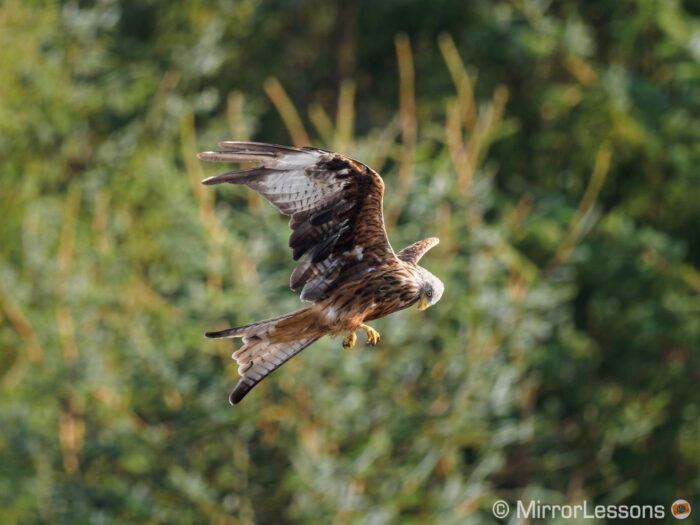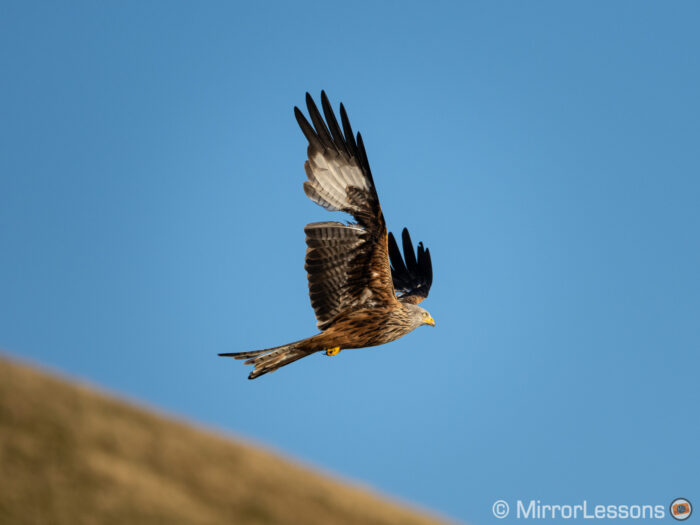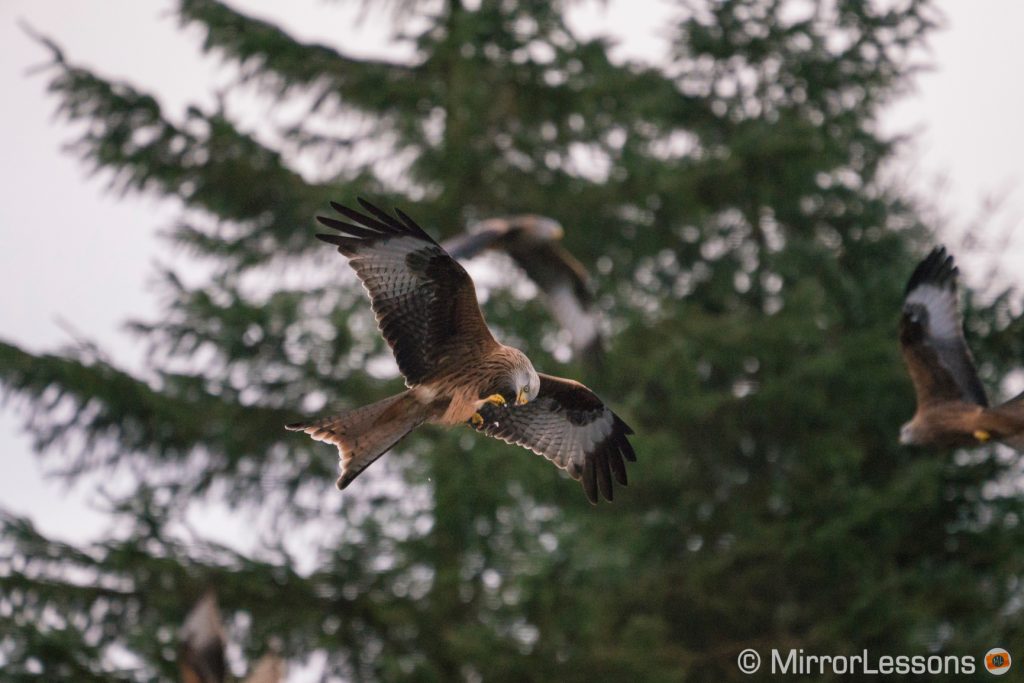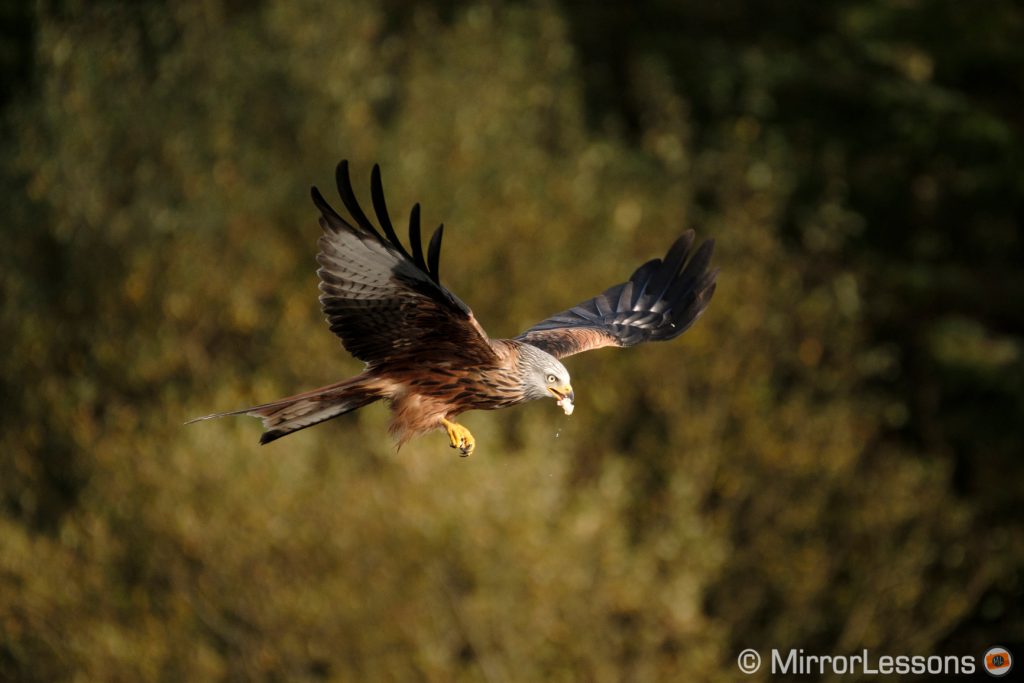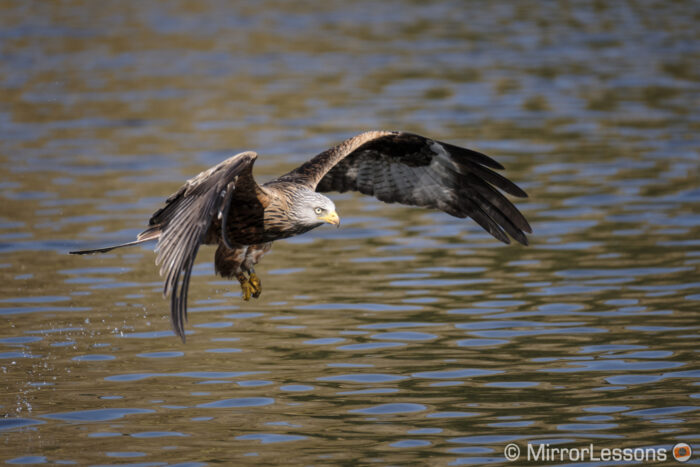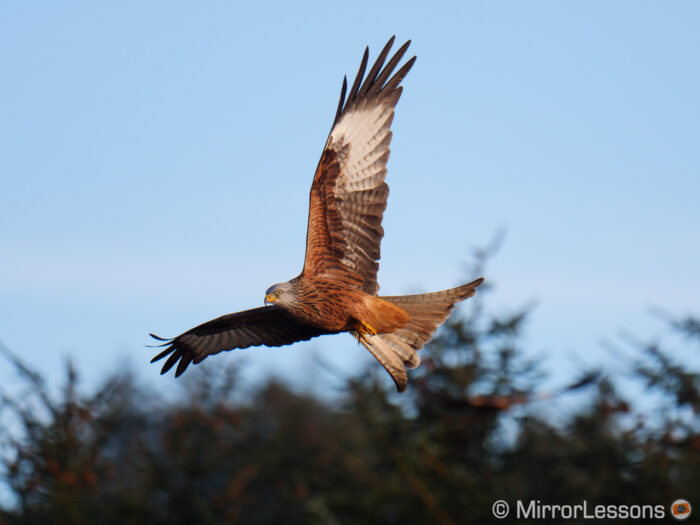A few years ago, our reader Alfredo suggested an idea for an article. Since we test the autofocus performance of many cameras at the same red kite feeding stations, why not publish a list of all the cameras we use with their keeper rate for birds in flight?
I liked his idea a lot and when the holiday break came, it gave me the opportunity to look at my notes (which luckily I kept for most of the cameras we reviewed) and build the article you’re reading right now.
Since then, I’ve continued to test new mirrorless cameras and update this post with new data and feedback. I also want to thank all of our readers who have visited, commented and made suggestions to improve the content.
If you’re curious to know which is the best mirrorless camera for bird photography, this article should give you a pretty good idea!
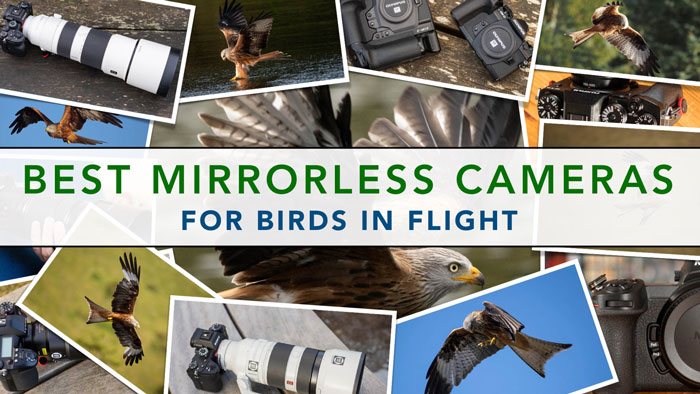
Ethics statement: All opinions expressed in this article are based on our real-world experience with each camera and lens. We were not asked to write anything about these products, nor were we provided any compensation of any kind. Within the article, there are affiliate links. If you decide to buy something after clicking the link, we will receive a small commission. To know more about our ethics, you can visit our full disclosure page. Thank you!
TABLE OF CONTENTS
1. Article Updates
2. Where I Perform The Test
3. How I Calculate The Score
4. AF Score and Drive Score
5. The Best Mirrorless Camera for BIF Ranked
6. Summary and Rankings
7. Additional Resources
Article Updates
- December 2023: Panasonic G9 II added
- October 2023: Nikon Z8 and Z7 II added
- September 2023: Canon R8 added
- July 2023: Lumix S5 II added
- June 2023: Sony A7R V added
- March 2023: Fujifilm X-H2 score and X-H2S firmware 3.0 feedback added
- February 2023: Canon R6 II added
- January 2023: Nikon Z9 added
- December 2022: Canon R7 and Sony A6600 added
- October 2022: Fujifilm X-H2S added
- August 2022: Canon R3 added
- June 2022: A7R IV and A7R III score updated
- April 2022: various changes to make the information more complete and easier to navigate
- March 2022: OM System OM-1 added
- February 2022: Sony A7 IV added
- January 2022: Fujifilm X-S10 added, X-T4 score updated
- November 2021: Sony A1 added, Sony A7 III score updated
- August 2021: Canon R5 added
- June 2021: updated the Panasonic G9 score after testing firmware 2.4
- November 2020: Canon EOS R6 score added
- October 2020: Nikon Z7 score updated
- September 2020: Nikon Z50 and E-M1 III added to the list, Nikon Z6 score updated, new ranking based on AF rate and burst speed added
- August 2020: Fujifilm X-T4 added to the list
Where I Perform The Test
The two locations I go to every time are the Red Kite feeding stations at Bwlch Nant Yr Arian and Gigrin Farm in Mid-Wales.
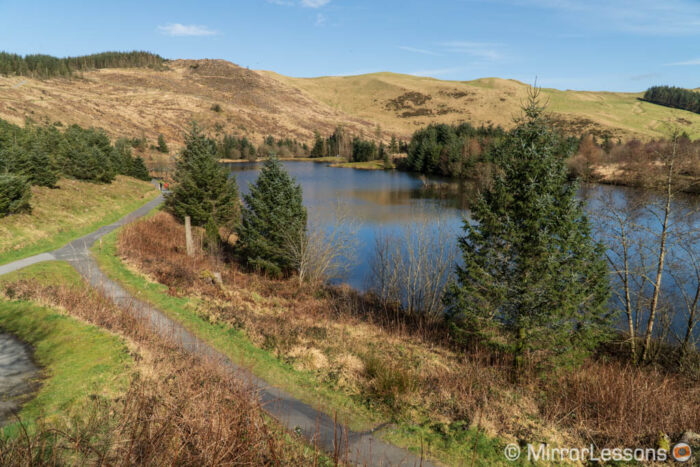
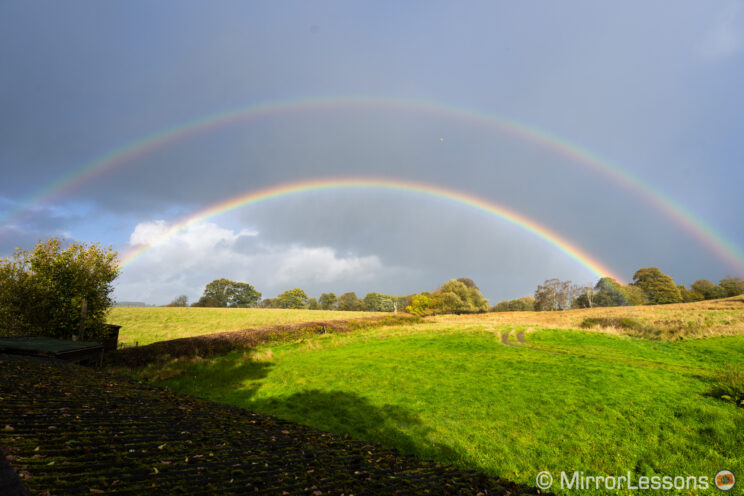
The action is pretty much always the same: close to 3pm (2pm in winter), the kites gather in the sky in large numbers (up to 150, more in the cold season). Once the meal is served, they dive in turns to grab the food. The feast can last for several hours depending on the day, the number of birds and the season.
The birds can fly quite close (Gigrin), or dive into the water to grab a piece of meat that another kite dropped (Bwlch Nant Yr Arian), giving us photographers an extra opportunity for a dramatic picture. There are also fights among the kites themselves, or with other birds.
The scenario is ideal because, in a couple of hours, I can take lots of images, try different settings and capture the birds when they are in the sky (plain background) or against the trees (busy background). Kites are fast, which gives the camera (and myself!) a nice challenge.
How I Calculate The Score
I transfer all the images to my computer and divide them into folders, according to the different settings used. Then, I start to analyse each photo and assign one of three labels:
- in focus: sharpness is excellent, details are crisp
- slightly soft focus: the image looks ok at first, but zooming in reveals it is not perfect (you can still perceive most of the details, but they are not as sharp as they could be)
- out of focus: the details of the bird are too soft and can be noticed without enlarging the image, or focus is completely off
When my analysis is complete, I calculate two percentages for each folder. This allows me to find out not only how the camera performed, but also which setting combinations gave me the highest score. I may also separate the percentages according to the position of the bird (plain or busy background) if there is a substantial difference in performance.
Green
In-focus images only. It’s the most severe score out of the two.
Blue
In-focus + slightly soft images. It is a more forgiving evaluation.
You may wonder why I bother with the blue score at all, and that is a legitimate question. When I started testing mirrorless cameras, I noticed that slightly soft results were more common than completely out of focus images, as opposed to DSLRs. Making this differentiation allows me to better understand how the camera performs and what the potential improvements could be.
We can also argue that an image may look good even if focus is only 90% accurate, and might still be usable in limited form if the action or the light captured is really beautiful.
AF Score and Drive Score
The AF Score represents the best keeper rate I got with a precise list of settings and a specific drive speed. It prioritises the autofocus performance rather than the fastest burst rate the camera can produce. For example, if a model can work at 20fps, but the keeper rate is better at 10fps, the AF Score will reflect the performance at 10fps.
The Drive Score shows the hit rate I got with the fastest continuous shooting speed available on the camera, as well as the number of ‘keepers’ (images in focus) in a 1 second burst. To keep things simple, the Drive Score only takes into account the green percentage.
Why make such a distinction?
The Drive Score was added later, following the suggestion of our reader Speeding in the comments. He rightfully argued that, even if a camera had an inferior AF score, it might still give you a higher number of good images per second because the drive speed is faster.
Which score should you give more importance to?
It depends on how much of a difference there is between the cameras. Let’s take an example:
- A7 IV: 94% (green) at 10fps – 9 / 10 images in focus
- X-T3: 72% (green) at 20fps – 14 / 20 images in focus
Despite the lower score, the X-T3 gives you more images in focus per second. Considering that wildlife is often about capturing difficult moments that may not happen again, many photographers will prefer to have more images on the SD card and that is a fair assessment.
Personally, I think the AF score gives you a more realistic representation of how much the camera can be trusted. The A7 IV may have a slower drive speed, but its autofocus is more realiable in every situation, whereas the X-T3 will struggle at times.
I would also consider the following:
- There are no settings that let you control where the out of focus images will end up in a sequence. The camera with the better AF has a higher chance of giving you good images where the action is at its most crucial (for example when a bird is grabbing a fish in the water).
- Some cameras may have more fps but the buffer might be limited. For example, the X-T3 won’t manage 2 seconds at 20fps (with RAW), so if the action lasts 4 seconds, the A7 IV will give you more images in focus.
- The continuous shooting speed you select in the menu and the actual speed the camera uses are not always exactly the same, and some settings can slow it down too (for example the X-T3 speed decreases when using Focus Priority, but the latter is an important setting to improve the AF rate).
- At the fastest rate, not every camera gives you live view in the EVF, which means there is a lag to consider and that can throw you off guard (resulting in a poorer score until you get used to it).
With all that said, there are times when the Drive Score matters most, and that is when the AF performance is very similar between cameras. Another example:
- A7 IV: 94% (green) at 10fps – 9 / 10 images in focus
- R6: 93% (green) at 20fps – 18 / 20 images in focus
- OM-1: 85% (green) at 50fps – 42 / 50 images in focus
The difference in AF score between the R6 and A7 IV is too small to be relevant in real world use, but the R6 has double the continuous shooting speed, so in this case there is no question that the Canon is the better performer (of course there are other differences like sensor resolution but that is not the point I’m making here).
As for the OM-1, it has a lower score but 8% or 9% is not a big difference, and that difference is easily counterbalanced by the impressive burst speed the camera can handle.
I think displaying both scores gives you a more complete overview of how each camera behaves.
And remember, these scores really focus around the autofocus performance and the number of ‘keepers’. There is so much more to make a camera good for wildlife and birds. This is why each score is accompanied by my comments and feedback about how it is to work with the camera in the field.
Variables and Firmware Updates
There are different things that can influence my test: less light (dark clouds instead of a sunny day), the time of the year and kites’ unexpected behaviour.
There are more kites during the winter and they can eat all the food in half an hour, which doesn’t give me a lot of time to try different settings. On other days, the birds may decide to keep their distance until no humans are present on the site, or wait until the sun goes down (between 4pm and 5pm).
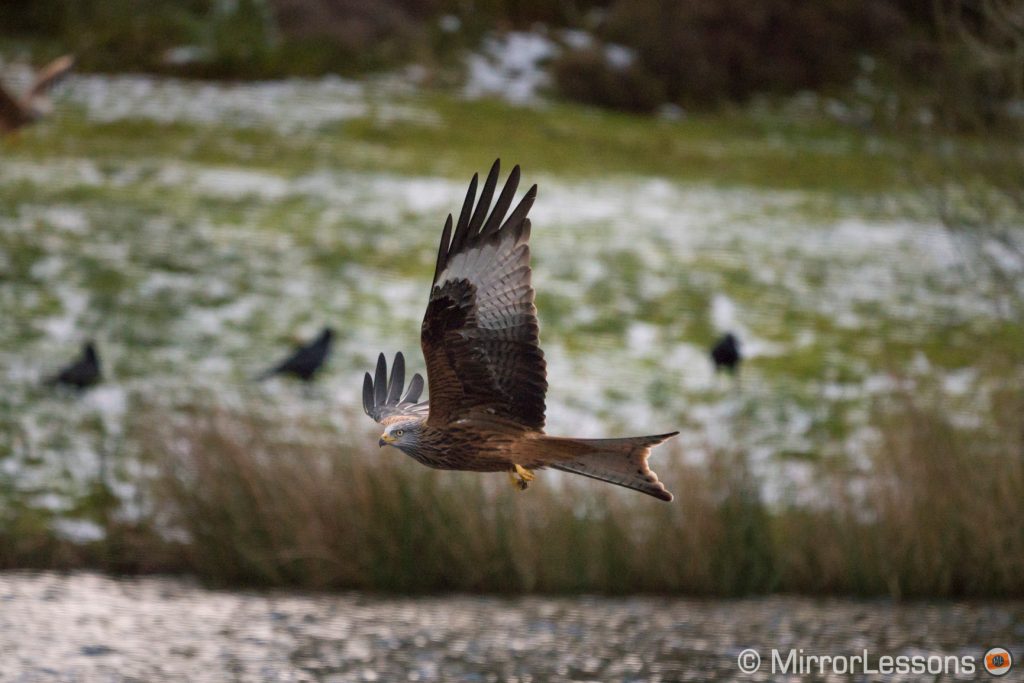
A very dark winter day while testing the A7R III.
If I’m not satisfied with a session, I always try to go back another day and start over, unless there is a reason that stops me from doing so (bad weather or rented gear that needs to be sent back for example). Depending on availability or my budget, I also try to use different lenses, when possible.
These variables rarely stop me from getting satisfying results. However, if I feel I didn’t have enough time with a particular camera, I make sure to mention it in the article.
Last but not least, manufacturers are now able to tweak the autofocus algorithm, introduce new features and improve the overall performance of their cameras with firmware updates. In some cases, it doesn’t make a difference for birds in flight, whereas in others, it can affect the score positively.
When a new firmware looks relevant, I always try to go back to the kites and test the camera again, but please note this is not always possible due to my working schedule, gear availability and other factors. This article is a solo and self-founded project.
For each product, I’ve included the latest firmware version that I was able to test. If a new firmware that looks interesting is out and I haven’t had a chance to test it yet, I will also mention it.
The Best Mirrorless Camera for Bird Photography
Below is a list of all the cameras I’ve tested. They go from the highest to the lowest AF score. I’ve also included extra information that is useful to know for bird photographers.
Sony A1
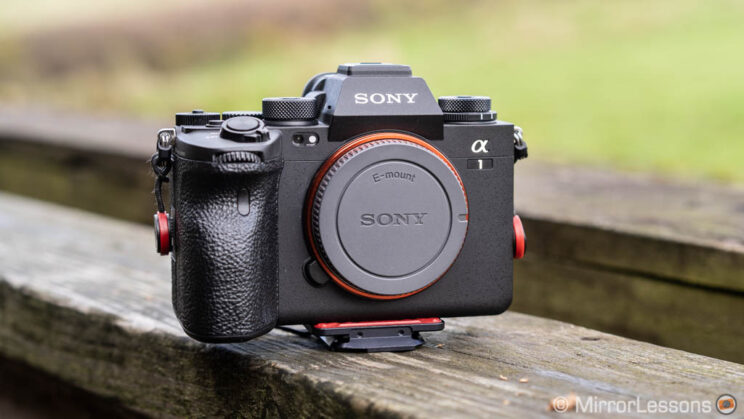
AF score
98%
100%
Lens used: FE 200-600mm F5.6-6.3 G OSS
Number of images taken: 2,991
Firmware version when last tested for BIF: 1.10
Drive score (20fps)
98%
19 / 20
Drive score (30fps)
94%
28 / 30
The A1 gave me a nearly perfect score, and I honestly can’t see how I will ever get something better than this (but obviously, I’m happy to be proven wrong). The Sony flagship doesn’t bring a huge advantage over the A9 II if you only look at the keeper rate, but when you factor in that it has double the sensor resolution and a faster burst rate, you understand what kind of beast this camera is.
The precision of the tracking mode is impressive, the responsiveness of the autofocus is ahead of anything listed below (A9 series excluded) and the performance stays at its highest even when shooting at 30fps. There is also Eye AF for birds, in addition to animals: it’s not essential when they are in flight, but it’s a great tool to use when they are static.
The best Sony A1 settings for birds in flight:
- AF-Area Mode: Tracking with Expand Flexible Spot (or Zone Area), Eye AF for Birds enabled
- Priority Setting in AF-C: Focus
- AF Track Sensitivity: 5 (Responsive)
- Drive Mode: Medium/10fps, Hi/20fps or Hi+/30fps (electronic shutter)
The A1 has so much more than just autofocus. In addition to the stacked 50MP sensor, it features 5-axis stabilisation, a superb viewfinder with 9.44M dots and no blackouts (when using the e-shutter), and 8K video. It can work with two CFexpress (type A) or two SD cards, or one of each. It features the latest design upgrade (like the A9 II and A7R IV), which means you get a more comfortable grip. The battery life is very good too. Anything bad to mention? Well, it’s expensive. But then, the camera is one of a kind.
Reminder: the links below are affiliate links. If you decided to buy something after clicking the link, we will receive a small commission.
Additional content:
Nikon Z9
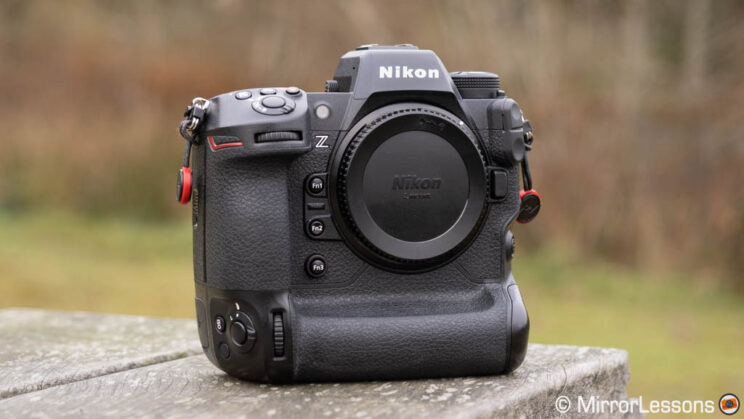
AF score
96%
100%
Lenses used: NIKKOR Z 800mm f/6.3 VR S, NIKKOR Z 100-400mm f/4.5-5.6 VR S, AF-S NIKKOR 500mm f/5.6E PF ED VR with FTZ II
Number of images taken: 10,899
Firmware version when last tested for BIF: 3.00
Drive score (20fps)
96%
19 / 20
Drive score (30fps)
79%
24 / 30
Drive score (120fps)
96%
115 / 120
The Nikon Z9 has received many positive reviews since it came out, and there is good reason for it. The camera delivers! It is at the same level as the Sony A1 and Canon R3, which means it is among the best you can buy for this genre.
Once I found the optimal settings for the red kites, the AF performance was flawless, whether I was using a native Z-mount lens, or the F-mount lens with an adapter. The Z9 had no hesitation and rarely mis-focused, even in difficult light conditions. The Animal Subject Detection algorithm is reliable and precise, even when the bird is not in a favourable position, or when it is small in the frame.
The buffer is not outstanding, but you don’t lose much speed once it becomes full when working at 20fps. If you’re happy with JPGs, you can go up to 120fps, although the resolution output decreases. There is the Pre-Release capture mode which can be invaluable, and the camera doesn’t have a mechanical shutter. It’s electronic only, with all the advantages that come with it, including blackout-free live view, and no visible rolling shutter.
The best Nikon Z9 settings for birds in flight:
- AF-Area Mode: 3D Tracking
- AF Subject Detection: Animal
- AF-C Priority Selection: Focus
- Focus Tracking With Lock-On: 3, Erratic
The 45.7MP sensor delivers plenty of details, with very good results up to 6400 ISO, and decent images up to 25,600 ISO. The RAW files are easy to work with, and the colours are excellent. There can be a bit of banding when opening the shadows too much, but we’re talking about extreme post processing, which hopefully you won’t need to do.
The camera is not as small and light as the Canon R3, but the design is very comfortable and the buttons/dials are easy to reach and use. The Z9 is built like a tank with advanced weather sealing. Battery life is excellent and the viewfinder, despite not sporting the most impressive specs, is actually rather good.
One of the aspect that surprised me the most is the stabilisation system. I recorded lots of 8K and 4K footage hand-held (or with just the help of a monopod), using long telephoto lenses (500mm, 800mm, sometimes combined with the TC 2.0x). There were no clips I had to delete. All the footage, while not perfect, was perfectly usable. I’ve never got this level of result with other full frame cameras before. This is a camera for wildlife filmmakers as much it is for wildlife photographers.
Reminder: the links below are affiliate links. If you decided to buy something after clicking the link, we will receive a small commission.
Additional content:
Nikon Z8

AF score
96%
100%
Lenses used: NIKKOR Z 180-600mm F5.6-6.3 VR
Number of images taken: 8,445
Firmware version when last tested for BIF: 1.01
Drive score (20fps)
90%
18 / 20
Drive score (30fps)
83%
25 / 30
Drive score (60fps)
93%
56 / 60
Drive score (120fps)
96%
115 / 120
The Nikon Z8 shares the same technology as the flagship Z9: the same sensor, the same AF system, the same processor, and the same drive speed. Therefore, it’s not surprising to see the performance closely resembling that of the larger camera.
The AF performance is among the very best, especially when working at the highest fps. It is incredibly fast at detecting the subject, acquiring focus, or correcting focus within a sequence. However, I was surprised to observe slightly lower performance when working with RAW at 20fps. The Z8 struggled a bit when the bird was smaller in the frame, occasionally switching to the background a bit too easily. You have to wait a few seconds to confirm that the camera has detected the subject before pressing the AF-ON button. If it misses the bird, you need to release the button and press it again to ‘force’ the Z8 to focus correctly.
The buffer is not extraordinary, but you don’t lose much speed once it becomes full when working at 20fps. If you’re satisfied with JPGs, you can shoot at up to 120fps, although this either sacrifices sensor area (60fps in DX mode only) or resolution (120fps works in full frame but results in an 11MP output). There’s also the Pre-Release Capture function, which is very useful when dealing with unpredictable action.
The best Nikon Z8 settings for birds in flight:
- AF-Area Mode: 3D Tracking or Custom Wide area
- AF Subject Detection: Animal
- AF-C Priority Selection: Focus
- Focus Tracking With Lock-On: 3 or 5, Erratic
The 45.7MP stacked sensor delivers excellent image quality, and thanks to the fast sensor readout and image processor, you get live view with no blackouts. In fact, the camera exclusively uses the electronic shutter, and distortion is very well-contained, with probably the least amount of rolling shutter effect among all the cameras in this list.
The design is fantastic; it feels like Nikon’s old top-end DSLRs, but in a good way: very solid construction, a comfortable grip, an excellent viewfinder, and even back-illuminated buttons. Battery life is not as good as the flagship Z9, but it performs well overall, considering the smaller unit.
The stabilization works well for video when recording static shots, although the Z-mount lenses also contribute with their excellent VR system. The possibilities for video are endless: 8K 60p, 4K 120p, ProRes, RAW, N-Log, and more, all internal!
Reminder: the links below are affiliate links. If you decided to buy something after clicking the link, we will receive a small commission.
Sony A9 / A9 II

AF score
96%
99%
Lenses used: FE 200-600mm F5.6-6.3 G OSS, FE 100-400mm F4.5-5.6 GM OSS with TC 1.4x
Number of images taken: 2,345 (combined)
Firmware version when last tested for BIF: 1.00 (A9 II) – 6.00 (A9)
Drive score (20fps)
96%
19 / 20
Note about the lenses: I used the 100-400mm and teleconverter with the A9 version 1.0 when, at the time, the 200-600mm was not available. The performance doesn’t decrease a lot with the TC 1.4x. That said, I consider the 200-600mm to be a better choice (lower price, longer reach, excellent quality).
The A9 II smashed my previous best score, which was taken with the Nikon D500 (85%/98%), and the A9 did the same when firmware 6.0 arrived. Finding only 1 blurred image out of more than a thousand doesn’t leave room for misinterpretation. Even the “slightly out of focus” photos were hardly distinguishable from the sharp images, so I had to be extremely picky.
The real-time AF tracking is the first tracking mode on a mirrorless model that is reliable for this genre. The blackout-free live view when shooting at 10fps or 20fps with the electronic shutter makes it so much easier to follow the kites. No other mirrorless camera comes close to this at the moment. In fact, the only competitor is the flagship A1.
The best Sony A9 / A9 II settings for birds in flight:
- AF-Area Mode: Tracking with Expand Flexible Spot (or Zone Area)
- Priority Setting in AF-C: Focus
- AF Track Sensitivity: 5 (Responsive)
- Drive Mode: Medium/10fps or Hi/20fps (electronic shutter)
The main differences between the A9 and A9 II are found on the outside. The mark II model inherits an upgraded design with a larger grip, thicker buttons and two UHS-II card slots.
The battery life is the best you can find and both bodies are weather sealed. The 24MP full frame sensor is excellent concerning dynamic range and high ISO. The RAW files drop to 12-bit when using the electronic shutter in continuous mode, which can limit shadow recovery with extreme post processing, but this has yet to cause me serious problems.
Reminder: the links below are affiliate links. If you decided to buy something after clicking the link, we will receive a small commission.
Additional content:
Canon EOS R3
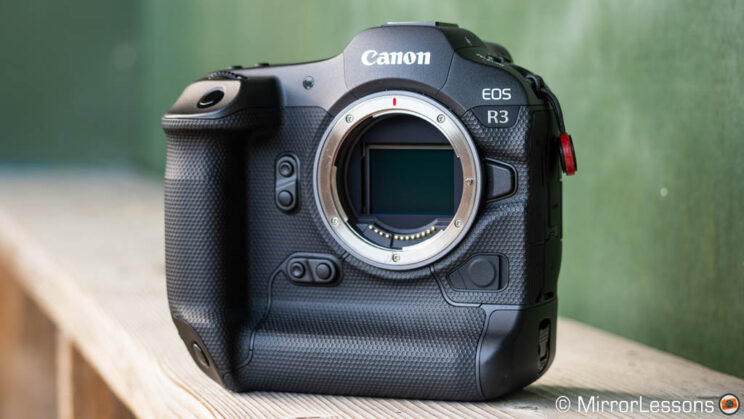
AF score
94%
100%
Lens used: RF 100-500mm F4.5-7.1 L IS USM, Extenders RF 1.4x and RF 2x
Number of images taken: 8,450
Firmware version when last tested for BIF: 1.2.1
Drive score (30fps)
94%
28 / 30
The Canon R3 really surprised me. The AF locking speed is impressive (probably the fastest on this list), and the animal detection software is very intelligent. It can stay glued to the subject no matter what passes in front of it. If it wasn’t for the occasional odd behaviour of focusing on the background, the R3 would certainly be at the top of the list. The autofocus is also very fast during video recording.
The R3 has a unique feature, Eye Control, which allows you to focus with your eyeball: simply look at your subject and press the AF button. It almost sounds like science fiction, but it works and is very precise, although I found you need a bit of time to get used to and trust it.
The best Canon R3 settings for birds in flight:
- AF area: Flexible Zone 1 (medium size)
- Servo AF: Case Auto
- Subject to Detect: Animals
- Eye Detection: Enable
- Tracking: off
- Switching tracked subjects: 0
- Lens drive when AF impossible: on
- Release Mode: 30fps (electronic shutter)
The sensor has 24MP, which may not be much compared to other cameras, but it is the best sensor Canon has ever produced, with excellent dynamic range and great high ISO capabilities. The readout speed is very good and you can shoot up to 30fps using the electronic shutter, with live view and no blackouts.
The R3 comes with weather sealing, plenty of controls and customisation, an excellent viewfinder, two card slots and a big battery. The user experience is fantastic and it is one of my favourite cameras on this list. It’s also one of the most expensive, but it is a true flagship model.
Reminder: the links below are affiliate links. If you decided to buy something after clicking the link, we will receive a small commission.
Additional content:
Sony A7 IV
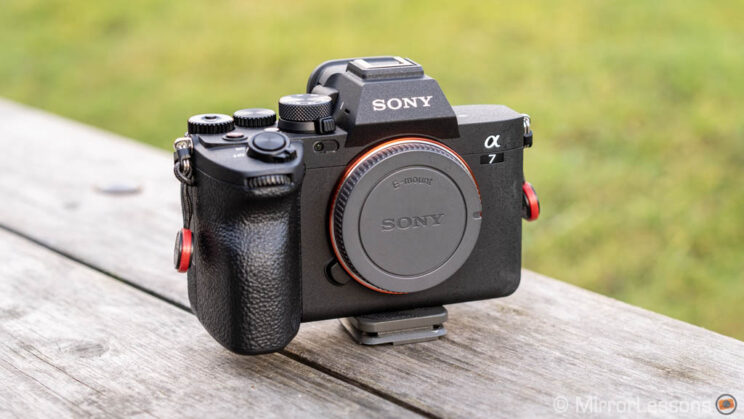
AF score
94%
99%
Lens used: FE 200-600mm F5.6-6.3 G OSS
Number of images taken: 1,316
Firmware version when last tested for BIF: 1.00
Drive score (10fps)
94%
9 / 10
The A7 IV received an important upgrade concerning the autofocus system, with real-time tracking and Eye AF for birds. While the latter is not essential for birds in flight, the tracking mode is very efficient in following the birds in favourable or difficult conditions. I was surprised to achieve a score close to what I got with the mighty A1 and the A9 series.
That said, there is a lack of consistency in the performance. Sometimes the camera nailed the sequences perfectly, other times it gave me a few out of focus or slightly soft shots. In other words, I find it difficult to nail a similar score on every outing. But overall, it is definitely a good improvement over its successor the A7 III.
The best Sony A7 IV settings for birds in flight:
- Focus Area: Tracking with Expand Flexible Spot (Eye AF can be left on or off, not a big difference)
- Priority Setting in AF-C: Focus
- AF Track Sensitivity: 5 (Responsive)
- Drive Mode: Hi or Hi+ (8fps or 10fps)
The camera has 33MP which is good for wildlife, and the new sensor also provides better dynamic range without hurting the high ISO much. The drive speed has not improved (still 10fps max.) but with the optional CFexpress Type A card, you get great buffer capabilities. Keep in mind that you need to choose compressed RAW or JPG to work at 10fps (otherwise it’s a ‘meh’ 6fps with lossless compressed RAW). The viewfinder is fine, and you also get good ergonomics and a long battery life.
Reminder: the links below are affiliate links. If you decided to buy something after clicking the link, we will receive a small commission.
Canon EOS R6 mark II

AF score
93%
99%
Lenses used: RF 100-500mm F4.5-7.1L IS USM
Number of images taken: 2,371
Firmware version when last tested for BIF: 1.1.1
Drive score (40fps)
93%
37 / 20
The R6 II gave me the same excellent results as its predecessor, the R6 mark 1, but it did so while shooting at double the frame rate! The autofocus performance is on par with the best in class, and the camera sports one of the fastest drive speeds you can find. The sensor readout is pretty good too, which means that rolling shutter is contained. The Animal subject detection works really well, for static and moving subjects, and the R6 II can recognise more species in comparison to the previous model.
The only real downside is the buffer: at 40fps with RAW, it can manage only a few seconds. Then the camera stops for 4 to 6 seconds before continuing at a slower speed (with further pauses). This means you have to time your sequence right. If you start too soon, you will miss important moments of the action.
You can improve the buffer by shooting at 20fps, or select JPG and C.RAW, but the latter delivers less quality in post with heavy post processing. The other option is the RAW Burst Mode, which improves the buffer significantly because the camera writes one large RAW file instead of hundreds of smaller files. The drawback is that you have to extract single RAW files in-camera one by one, or via the Canon desktop software. The RAW Burst mode also contains the Pre-Shooting setting, where the camera saves 15 frames before the shutter button is fully pressed.
The best Canon EOS R6 II settings for birds in flight:
- AF Zone: Flexible Zone 1 (medium size)
- Subject Tracking: on
- Subject to Detect: Animals
- Eye Detection: Auto
- Switching tracked subjects: 0
- Servo AF: Case Auto
- Lens drive when AF impossible: on
- Drive: 20fps / 40fps (electronic shutter)
- Stabilisation: Off (or Mode 2)
The R6 mark II features an excellent 24.2MP full frame sensor, very good ergonomics, a nice viewfinder and two SD card slots. The battery life is fine, and there are also excellent video capabilities with 4K 60p and no sensor crop, as well as internal 10-bit 4:2:2, or 12-Bit Prores RAW via the HDMI port. It’s a very complete camera, and one of the best I’ve tested lately.
Reminder: the links below are affiliate links. If you decided to buy something after clicking the link, we will receive a small commission.
Canon EOS R8
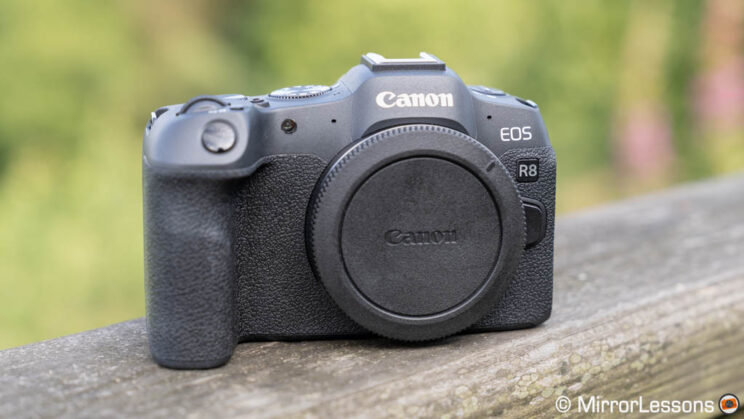
AF score
93%
99%
Lenses used: RF 100-500mm F4.5-7.1L IS USM
Number of images taken: 1,668
Firmware version when last tested for BIF: 1.0
Drive score (40fps)
93%
37 / 40
The R8 shares the same 24.2MP full-frame sensor, processor, and autofocus system as the R6 II, and unsurprisingly, it gave me the same top-of-the-class results! It’s super fast, and rolling shutter is well-contained. Animal subject detection works exactly as it should, whether you’re taking pictures of static or moving subjects.
The buffer is not extraordinary, especially at 40fps with RAW; it will only last for two seconds before taking a 6-second break. You have to time the moment you press the shutter button carefully, or you may miss the most interesting moments of the action.
The buffer improves if you’re shooting at 20fps or working with C.RAW. Another option is to use the 30fps RAW Burst Mode, which improves the performance quite a bit because the camera writes one large RAW file instead of hundreds of smaller files. The annoying thing is that you have to extract single RAW files in-camera or via the Canon software, one by one (there is no batch option). The RAW Burst mode also includes the Pre-Shooting option, where the R8 pre-loads 15 images before the shutter button is pressed all the way down.
The best Canon EOS R8 settings for birds in flight:
- AF Zone: Flexible Zone 1 (medium size)
- Subject Tracking: on
- Subject to Detect: Animals
- Eye Detection: Auto
- Switching tracked subjects: 0
- Servo AF: Case Auto
- Lens drive when AF impossible: on
- Drive: 20fps / 40fps (electronic shutter)
- Stabilisation: Off (or Mode 2)
Where the R8 finds itself inferior to the R6 II is in the body design: you get a smaller viewfinder, a smaller front grip, only one SD card slot, no AF joystick, and a smaller battery. The video capabilities remain the same with 4K 60p and no sensor crop, as well as internal 10-bit 4:2:2, but you’re more limited for long recording sessions, especially in 4K 60p.
Reminder: the links below are affiliate links. If you decided to buy something after clicking the link, we will receive a small commission.
Canon EOS R6
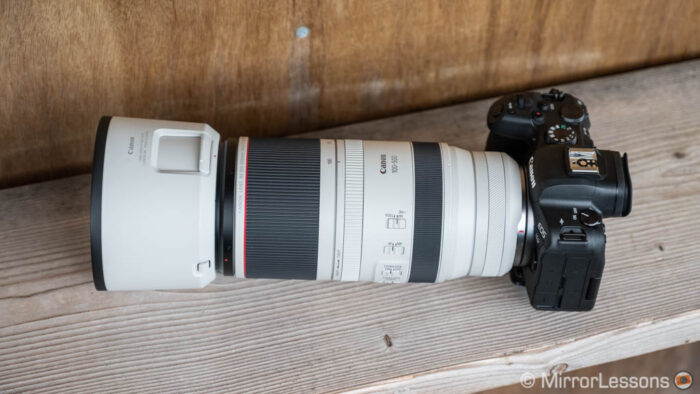
AF score
93%
97%
Lenses used: RF 100-500mm F4.5-7.1L IS USM, RF 600mm F11 IS STM, EF 800mm F5.6 IS USM with adapter
Number of images taken: 5,180
Firmware version when last tested for BIF: 1.7.0
Drive score (20fps)
93%
18 / 20
The EOS R6 proved to be a formidable contender and is the camera that gets the closest to the Sony A9 II, with whom it shares the same maximum continuous shooting speed of 20fps when using the electronic shutter.
The Canon has a lot of settings to control the autofocus and there is a bit of a learning curve to understand them all. The good news is that even with non-ideal settings, the hit rate doesn’t go below 83%. That said, it’s worth spending time to find the best configuration to get the maximum performance. The animal detection mode is a setting you want to make sure to have enabled. Its speed and reactivity is impressive, switching constantly from the body, head or eye depending on the bird’s position. If it wasn’t for the occasional misfocused shots on the background, the R6 would probably be at the very top of this list.
The best Canon EOS R6 settings for birds in flight:
- AF method: Tracking with Animals subject detection
- Initial Servo AF point for Tracking: Auto
- Servo AF: Case 3 (default settings)
- Switching Tracked subjects: 0 or 1
- Lens drive when AF impossible: ON
- Release Mode: 20fps with electronic shutter
The sensor resolution of 20MP might seem a bit low for birds and wildlife if you need to crop (this is where its sister R5 could be more interesting), but the high ISO performance is good and there is plenty of dynamic range to work with. Rolling shutter is contained and a non-issue for birds when using the electronic shutter mode. Then we have weather sealing, in-body stabilisation, a good viewfinder and two SD card slots.
Reminder: the links below are affiliate links. If you decided to buy something after clicking the link, we will receive a small commission.
Nikon Z7 II
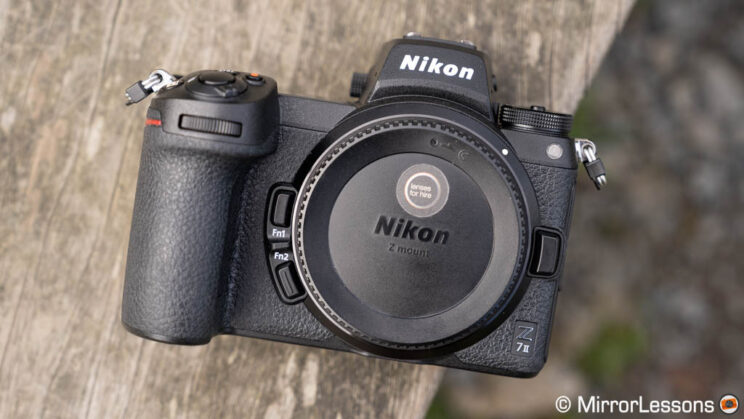
AF score
91%
98%
Lenses used: Z 180-600mm F5.6-6.3 VR
Number of images taken: 926
Firmware version when last tested for BIF: 1.60
Drive score (5.5fps)
91%
4 / 5
Drive score (10fps)
77%
7 / 10
Note: The original Z7 (firmware 3.12) was tested with the Z 70-200mm F2.8 and TC 1.4x, a shorter focal length than usual for this article. Therefore, I decided to update this paragraph and concentrate on the Mark II model. The best keeper rate with the original Z7 was 88% / 96% at 5.5fps. The best settings highlighted below are also valid for the mark 1 model.
When the first Z-mount cameras were unveiled, Nikon’s autofocus system received a lot of criticism. However, when I tested it for the first time in 2018 (using the Sigma Sigma 150-600mm Contemporary with FTZ adapter), it proved to be better than expected. Nikon then released various firmware updates, before bringing additional improvements with the second-generation Z7 Mark II.
There are a few compromises to be made, such as choosing the slower Hi continuous shooting mode, which works at 5.5fps. However, when coupled with the correct focus settings, the Z7 II is very capable. The camera understands where the subject is and rarely misfocuses on the background.
The best Nikon Z7 / Z7 II settings for birds in flight:
- AF-Area Mode: Wide-area (L) (don’t use the Tracking mode)
- AF-C priority selection: Focus
- Focus tracking with lock-on: 1 (Quick)
- Release Mode: Continuous Speed High (5.5fps)
- Shutter: Mechanical
The Z7 II can shoot up to 10fps (9fps with 14-bit RAW) but you don’t get live view. Instead, the last images taken are shown in rapid succession in the EVF. To get live view, you need to decrease the speed to 5.5fps which is not the fastest for capturing animals, but that is the setting where the camera performs best. The design includes weather-sealing, an decent EVF and two card slots (CFexpress Type B and SD UHS-II). The image quality is on par with the Z8/Z9, which is excellent news.
Reminder: the links below are affiliate links. If you decided to buy something after clicking the link, we will receive a small commission.
Additional content:
Canon EOS R5
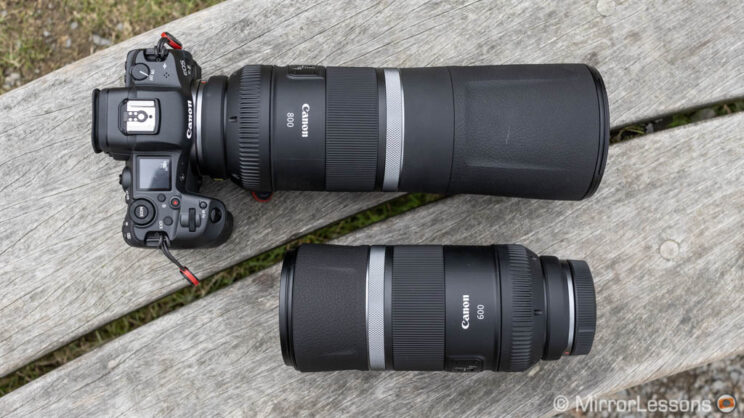
AF score
90%
99%
Lenses used: Canon RF 100-500mm F4.5-7.1L IS USM, RF 600mm F11 IS STM, RF 800mm F11 IS STM
Number of images taken: 1,880
Firmware version when last tested for BIF: 1.3.1
Drive score (20fps)
90%
18 / 20
Notes: firmware 1.5.2 should improve the AF performance and possibly the score.
The camera gave me excellent results with all three lenses.
Like its siblings the R6, the Canon EOS R5 shows how much Canon mirrorless cameras have improved, not just for the autofocus who’s potential has always been high, but also in terms of speed and image quality. The R5 features a very good 45MP sensor and, despite the higher resolution, is capable of handling the same drive speed of 20fps like the 20MP R6.
The autofocus settings are also the same and there is a lot you can control. It will take some time to learn all the options available in the 5-pages AF menu of the camera. The most important setting, and one of the most effective, is to enable Animal detection which works really well for static and moving subjects, and very rarely lets you down. The rating is a tad below that of the R6, but a 3% difference is a negligeable variance.
The best Canon EOS R5 settings for birds in flight:
- AF method: Tracking with Animals subject detection
- Initial Servo AF point for Tracking: Auto
- Servo AF: Case 3 (default settings)
- Switching Tracked subjects: 0 or 1
- Lens drive when AF impossible: ON
- Release Mode: 20fps with electronic shutter
The image quality is sligthly below the R6 when it comes to high ISO, but does a bit better with dynamic range, especially when recovering shadows. Needless to say, the 45MP resolution is helpful to crop and magnify your subject when you can’t get close enough.
I didn’t find any issues with distortion when using the electronic shutter. Image stabilisation is really good, even with the 800mm lens. The camera is very well built and has weather sealing. There are two memory card slots, but the first one is for the more expensive CFexpress card, and there is no retro-compatibility with XQD cards.
Reminder: the links below are affiliate links. If you decided to buy something after clicking the link, we will receive a small commission.
Additional content:
OM System OM-1
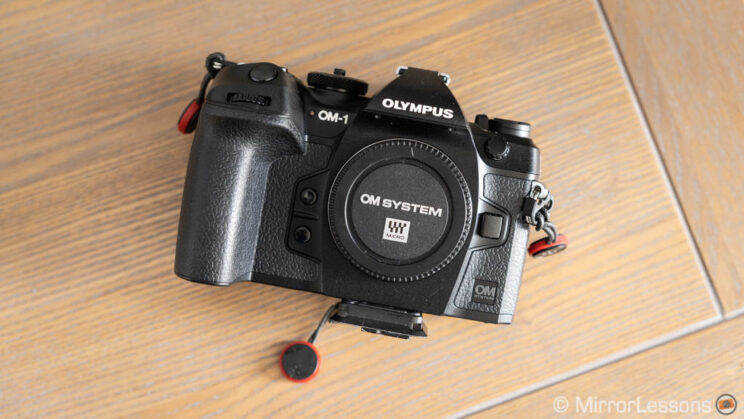
AF score
89%
98%
Lenses used: M.Zuiko ED 300mm F4 Pro IS, M.Zuiko ED 100-400mm F5-6.3 IS, Leica DG 100-400mm F4-6.3 OIS, Leica DG 200mm F2.8 OIS
Number of images taken: 17,171
Firmware version when last tested for BIF: 1.3
Drive score (10fps)
89%
9 / 10
Drive score (50fps)
85%
42 / 50
Note: good and consistent performance with all four lenses. Only at 400mm with the two zooms, or when using a teleconverter, the speed decreased a little.
I’ve re-tested the camera with firmware 1.2 and 1.3, but I didn’t find substantial differences with the AF performance.
OM Digital Solutions promised two things when launching the OM-1. One of them was a better autofocus system, and I’m happy to say they have delivered. The camera feels nothing like any previous OM-D model: it is much more reactive, much faster and has a better understanding of where the subject is at all times.
Bird Subject Detection is the key setting that improves the keeper rate, whether the bird is flying or not. The camera can easily recognise the eyes, head and body, and can also detect small subjects at a distance with busy backgrounds, or when they are partially hidden. With birds in flight, Subject Detection drastically reduces the chance of the OM-1 mis-focusing on the background.
The best result I got was with the 10fps burst using the mechanical shutter, but working at 20fps or 50fps with the electronic shutter only decreased the score by a few points. Up to 20fps, you see live view with blackouts. At 50fps, there is live view and no blackouts which really helps with erratic subjects. The camera can also work at 120fps but focus and exposure are locked on the first frame. Also, 50fps and 120fps are limited to specific lenses.
The best OM-1 settings for birds in flight:
- AF-Target Mode: Large
- Subject Detection: Birds
- Release Priority: Off
- AF Sensitivity: +2
- AF Scanner: On
- Drive Mode: 10fps (mechanical shutter), 25/50fps (electronic shutter)
The other thing that OM Digital Solutions promised is better image quality but the difference is not as substantial as some might hope it would be. Still, there is better colour accuracy and details at high ISO, and a bit more details preserved in the highlights.
As for everything else, the camera has a 20MP stacked BSI sensor and lots of extra features including Pro Capture, which is useful for unpredictable small birds flying off a branch for example. The ergonomics are fantastic, and the viewfinder (finally) got the upgrade it deserves with a 5.76M dot panel. The battery life is on par with previous models, but the fastest continuous shooting speeds will drain it faster.
Reminder: the links below are affiliate links. If you decided to buy something after clicking the link, we will receive a small commission.
Check price of the OM System OM-1 on
Amazon | B&H Photo
Additional content:
Sony A7R IV / A7R IVA
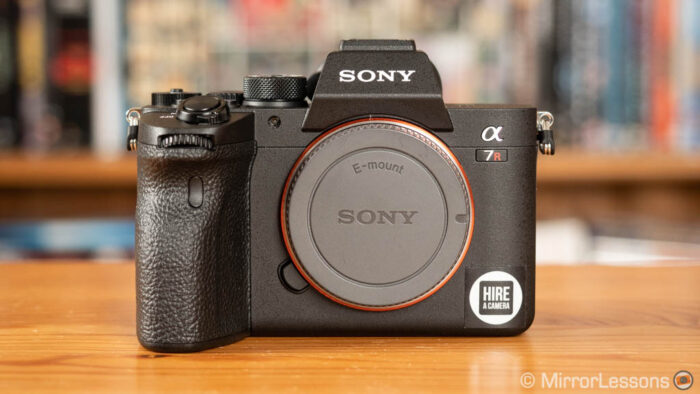
AF score
88%
100%
Lens used: FE 200-600mm F5.6-6.3 G
Number of images taken: 939
Firmware version when last tested for BIF: 1.20
Drive score (10fps)
88%
8 / 10
The fist time I tested the A7R IV, it performed in a similar way to its predecessor (63%/90%), despite the improvement brought to the AF system. Three years later, with the latest firmware and a different copy of the 200-600mm lens, the results is closer to what I originally expected. The real-time tracking mode makes a difference and is the setting that gave me the best keeper rate.
The best Sony A7R IV settings for birds in flight:
- Focus Area: Tracking with Expand Flexible Spot
- Priority Setting in AF-C: Focus
- AF Track Sensitivity: 5 (Responsive)
- Drive Mode: Hi (8fps) or Hi+ (10fps)
The A7R IV features a stunning 60MP sensor but, despite the huge resolution, the buffer is surprisingly good when shooting at 8 or 10fps. You can take advantage of the APS-C crop for extra reach, and you still get 26MP to play with. Naturally you can decide to crop later in post. After all with 60MP, there is lots of leeway for cropping which is quite useful for wildlife and bird photography. The camera also introduces a better build, thicker buttons, an improved grip and a stellar 5.76M dot EVF.
Reminder: the links below are affiliate links. If you decided to buy something after clicking the link, we will receive a small commission.
Additional content:
Sony A7 III
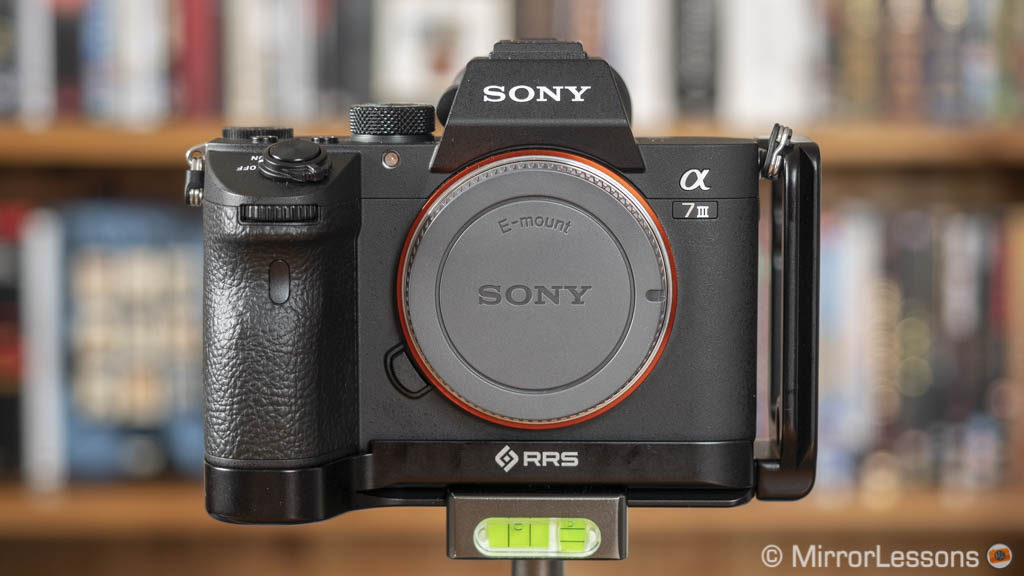
AF score
86%
99%
Lens used: FE 100-400mm F4.5-5.6 GM + TC 1.4x, FE 200-600mm F5.6-6.3 G, Tamron 150-500mm F5-6.7, Sigma 150-600mm DG DN Sports
Number of images taken: 1,066
Firmware version when last tested for BIF: 3.10
Drive score (8fps)
86%
6 / 8
Drive score (10fps)
81%
8 / 10
Note: the 200-600mm and the Tamron 150-500mm gave me the best score. The Sigma is inferior by about 10 points (75% / 91%). The 100-400mm with TC 1.4x were used in 2018 with firmware 1.0.
The A7 III shares a few specs with the A9 (specifically the number of AF points) but, despite not having the same processing and calculation speed, it proved a very good contender for this genre. The first score I got with the A7 III was 77% / 96%, soon after the camera came out in 2018. It was a good result at the time, obtained in mixed weather conditions, and it showed all the improvements made in comparison to the predecessor, the A7 mark II.
The score got better more when I tested the camera again later with other lenses, mainly the Sony 200-600mm and Tamron 150-500mm. The camera had also received various firmware updates that might have contributed to the boost in performance.
The best Sony A7 III settings for birds in flight:
- Focus Area: Zone
- Priority Setting in AF-C: Focus
- AF Track Sensitivity: 5 (Responsive)
- Drive Mode: Hi (8fps)
The 24MP BSI sensor is excellent in every way. You have two SD card slots, great battery life, weather-sealing and a good continuous shooting speed of 10fps – although, as with the A6400, I prefer to use the 8fps mode to keep a live view. The refresh rate and resolution of the viewfinder are not the best, but it has a good magnification. The ergonomics, like the A9 mark I, are not its strongest point, especially with large telephoto lenses. A grip extender or battery grip is advised.
Reminder: the links below are affiliate links. If you decided to buy something after clicking the link, we will receive a small commission.
Additional content:
Nikon Z6
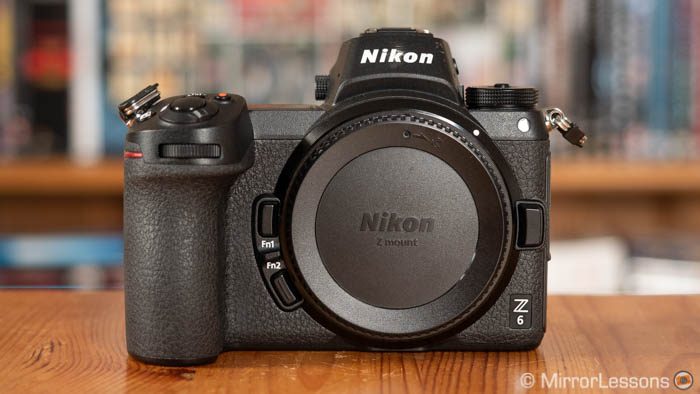
AF score
86%
95%
Lens used: AF-S NIKKOR 300mm F4E PF with TC 1.4x III and TC 2.0x III, Z 70-200mm F2.8 with TC 1.4x
Number of images taken: 1,347
Firmware version when last tested for BIF: 3.10
Drive score (5.5fps)
86%
4 / 5
Drive score (12fps)
82%
9 / 12
When I tested the Z6 in 2019 with the Sigma 150-600mm Contemporary lens, I got a respectable score of 73% / 88%. One year later, I got the chance to try it again, this time with the compact 300mm f4 PF, the 2.0x teleconverter and the latest firmware update. I wasn’t expecting to see such an improvement!
If last year the Z6 was a very capable already, this time it proved to be one of the very best mirrorless camera when it comes to autofocus and keeper rate. It does an excellent job of understanding where the bird is and locks onto it really fast. Unlike the D500 DSLR, the Tracking mode doesn’t produce the best results, so you need to choose the Wide-area Large setting instead.
The best Nikon Z6 settings for birds in flight:
- AF-Area Mode: Wide-area (L)
- AF-C priority selection: Focus
- Focus tracking with lock-on: 1 (Quick)
- Release Mode: Continuous Speed High 5.5fps
The Z6 can shoot up to 12fps but live view is deactivated and you see the last image taken instead. To have live view (with blackouts), you need to select the lower setting which decreases the burst speed to less than half. The camera is comfortable to hold, is very well-built and has weather sealing. There is a good EVF, excellent image quality (24MP full frame sensor), but one card slot only (XQD / CFexpress) and the buffer is not great when shooting at the fastest burst speed.
Reminder: the links below are affiliate links. If you decided to buy something after clicking the link, we will receive a small commission.
Additional content:
Sony A6600

AF score
85%
98%
Lens Lenses used: FE 200-600mm F5.6-6.3 G OSS
Number of images taken: 548
Firmware version when last tested for BIF: 1.10
Drive score (10fps)
85%
8 / 10
The A6600 has many things in common with the less expensive A6400, including the sensor and the autofocus. The main benefit for birds in flight is the larger battery, which improves the performance significantly.
I tested this camera very late in the game (2022), but was pleased to see that the three year old AF system (which was the beginning of Sony’s deep learning algorithm) can still produce excellent results. In fact, the keeper rate is higher than newer and more advanced cameras listed here. There are only a few settings to worry about, which makes the Sony model easy to configure.
The best Sony A6600 settings for birds in flight:
- Focus Area: Zone
- Priority Setting in AF-C: Focus
- Drive Mode: Hi+ (10fps) or Hi (8fps, with live view you and blackouts)
It’s a very compact camera, so the grip is not generous enough for large lenses. The FE 200-600mm was an easy pick for me since I own it, but I would not recommend it: it is too large for such a small camera. You should consider the Tamron 150-500mm instead.
The viewfinder is small, there are key buttons missing (AF joystick), only one SD card slot and you also have to deal with Sony’s old menu system. The drive speed of 10fps is ok but there are many cameras that offer faster bursts now. The image quality is very good otherwise.
Reminder: the links below are affiliate links. If you decided to buy something after clicking the link, we will receive a small commission.
Sony A7R V
AF score
84%
97%
Lens Lenses used: FE 200-600mm F5.6-6.3 G OSS
Number of images taken: 3,306
Firmware version when last tested for BIF: 1.10
Drive score (10 fps)
84%
8 / 10
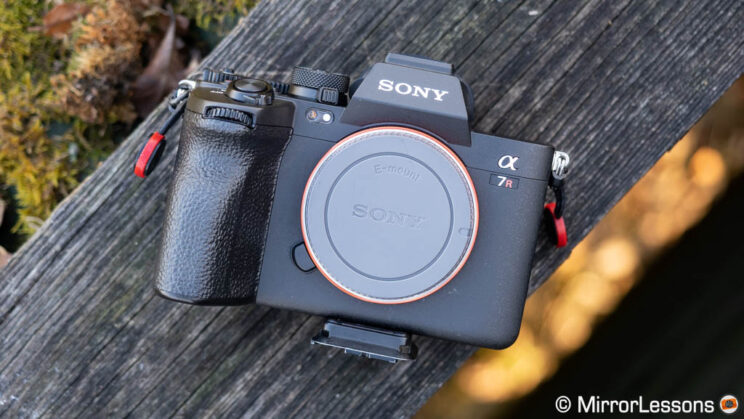
The A7R V introduced Sony’s next generation AF system with more phase detection points but, above all, more deep learning technology with a dedicated AI processing unit to boost subject detection. The camera can recognise different parts of a bird (body, head, eye), and is also capable of detecting smaller animals in the frame, even when they are in different positions.
For static birds, it works really well, and the A7R V is probably one of the best, if not the best camera for that. But the same cannot be said for birds in flight: the camera struggled to match the same score of its predecessor, with the feeling that the very advanced software inside needs some tweaking. It is also a much more complicated camera to set up, because of the addition of new advanced autofocus settings to control subject detection. All the other Sony cameras listed in this article are way easier to configure, and more than one give better results.
The best Sony A7R V settings for birds in flight:
- Focus Area: Tracking with Zone
- Subject Recog. in AF: On
- Recognition Target: Bird
- Tracking Shift range: 1 (narrow)
- Tracking Persistence Lvl: 3 (standard)
- Recognition sensitivity: 5 (high)
- Recognition part: Eye/Head/Body
- Priority Setting in AF-C: Focus
- Aperture Drive in AF: Focus priority
- AF Track Sensitivity: 5 (Responsive)
- Drive Mode: Hi (8fps)
- Steadyshot: Off
The A7R V features the same 61MP sensor of the mark IV model, which is excellent for wildlife photography (the APS-C crop still delivers a respectable 26MP). The buffer is flawless when using the CFexpress cards, but the drive speed goes up to 10fps max. The viewfinder is one of the very best on the market (9.44M dots, 0.64-in, 0.90x magnification) and the 4-axis LCD mechanism is clever and functional.
Reminder: the links below are affiliate links. If you decided to buy something after clicking the link, we will receive a small commission.
Panasonic S5 II
AF score
83%
96%
Lenses used: Sigma 150-600mm F5-6.3 DG DN OS Sports
Number of images taken: 3,401
Firmware version when last tested for BIF: 2.00
Drive score (30fps)
71%
21 / 30
Drive score (7fps)
83%
5 / 7
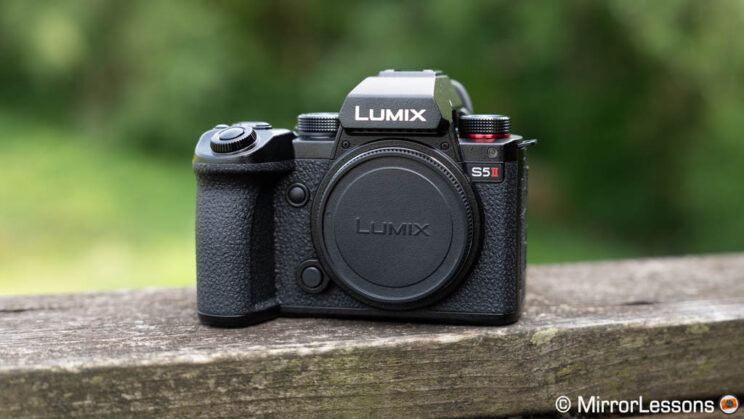
The Lumix S5 Mark II is the first camera from Panasonic that passed the 80% keeper rate mark in my test, and its AF score is substantially better than any previous model I tested. The explanation for this improvement is rather simple: phase detection. The S5 II is the first to employ this technology, after years of DfD contrast AF stubbornness (to be fair, it still uses DfD, but in S-AF only).
The S5 II manages birds in flight against a busy background much better: the performance is consistent, and you can trust it. You need to disable subject detection for the best results, as well as ignore the tracking mode; those two settings are too erratic. I also think that the performance could be even better with a more premium lens. I find the Sigma 150-600mm Sports to have a slow AF motor compared to other lenses, but it’s the only one that was available when I rented the gear.
The S5 II can also shoot up to 30fps with the electronic shutter, and with a decent buffer memory, although rolling shutter is noticeable with fast movements. It’s a shame Panasonic didn’t include a Pre-Burst mode, unlike older models such as the G9. It also got rid of 4K/6K Photo capture.
The best Panasonic S5 II settings for birds in flight:
- AF Mode: Zone (largest)
- Animal Detection: Off
- AF Custom Setting: +1, +1, 0
- Focus Priority for AFC
- Back Button Focus: AF-ON Near Shift
- Drive Speed: H 7 fps
- Shutter: mechanical
- Stabilisation: Off
The 24MP resolution may not be the most desirable for wildlife, but you get all the other benefits of a full-frame sensor: great dynamic range and excellent high ISO performance.
The camera offers excellent ergonomics, a straightforward button layout, and a comfortable grip. Battery life is good, and you also have two SD UHS-II card slots. The lens choice is not the vastest compared to other full-frame systems, but at least you have affordable options thanks to Sigma.
Fujifilm X-H2S
AF score
82%
97%
Lenses used: XF 100-400mm F4.5-5.6, XF 150-600mm F5.6-8
Number of images taken: 15,468
Firmware version when last tested for BIF: 3.01
Drive score (40fps)
82%
33 / 40
Drive score (20fps)
82%
33 / 40
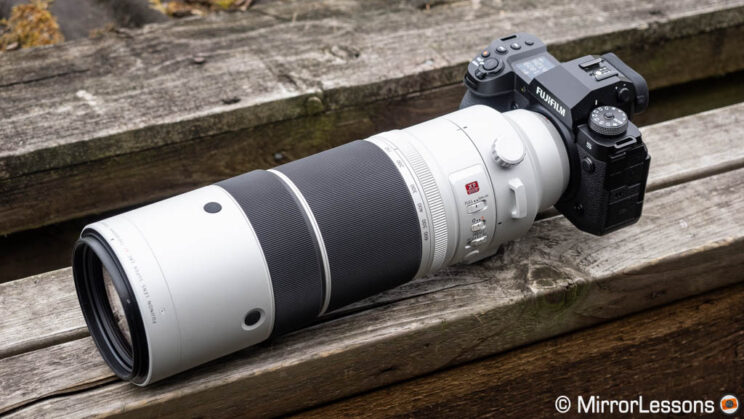
The X-H2S didn’t bring the substantial improvement I had hoped for. The results are comparable to the X-T4, or even the X-S10, as far as birds in flights are concerned. The main problem the series still faces is the struggle to keep the bird in focus throughout the entire sequence, especially when the animal flies in front of a busy background (trees, etc.). The behaviour is often unpredictable. I tried all sorts of setting combinations, but couldn’t find something that would make a drastic difference. The addition of bird subject detection AF doesn’t help. In fact, I had to turn bird AF off to get better results. I tested the X-H2S again with firmware 3.01 but unfortunately, the performance didn’t improve for birds in flight.
That isn’t to say the X-H2S is not a good performer for wildlife photography in general. The score is decent and the advantages are tangible in comparison to other APS-C cameras: a large grip, great customisation, faster sensor readout and continuous shooting speeds up to 40fps with live view and no blackouts (only the OM-1 is faster on this list as far as drive speed goes). Bird and Animal subject detection is very useful for static or slow moving subjects.
The best Fuji X-H2S settings for birds in flight:
- Focus Area: Zone 7×7
- Focus Priority
- AF-C Custom Settings: Set 6 (4, 2, Center)
- Subject Detection: off
- Performance: Boost 120fps
- Drive Mode: 20, 30 or 40fps with electronic shutter
The X-H2S offers the same resolution as the X-T4, but the sensor is stacked, offering more speed as described above, as well as less rolling shutter effect when panning quickly (with the electronic shutter). The video capabilities are impressive, with a maximum of 6.2K (3:2 aspect ratio), 4K 120p (with a sensor crop), unlimited recording and a great choice of internal codes and bitrates. There are two slots, one for CFexpress cards and one for SD cards. The battery life is good, but can decrease more rapidly when the boost mode is active, which is necessary to get the best AF performance the camera can deliver.
Reminder: the links below are affiliate links. If you decided to buy something after clicking the link, we will receive a small commission.
Additional content:
Panasonic G9 II
AF score
82%
96%
Lenses used:200mm F2.8 Leica DG Elmarit Power O.I.S, M.Zuiko 300mm F4 Pro IS
Number of images taken: 2,362
Firmware version when last tested for BIF: 1.00
Drive score (60fps)
82%
49 / 60
Drive score (20fps)
82%
16 / 20
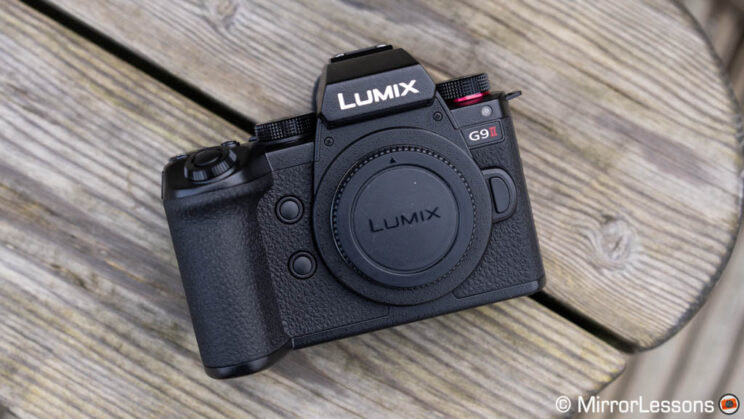
The G9 II is Panasonic’s second camera to feature phase detection autofocus, a significant improvement from its predecessor, which relied solely on contrast-detection AF. Its performance closely resembles that of the S5 II full-frame camera but with notably faster drive speed. I was surprised by the G9 II’s consistent keeper rate, wether it was operating at 60fps or 10fps.
Compared to its predecessor, the camera copes much better when capturing birds against busy backgrounds, which used to be a weak point for the first-generation G9 (and most Lumix cameras using DfD autofocus). It’s not flawless; changes in background contrast can occasionally lead to out-of-focus shots. However, overall, the performance is more consistent and predictable now.
The G9 II also features the Pre-Burst mode, allowing image capture before fully pressing the shutter release button. The fastest drive speeds work with the electronic shutter, and the sensor readout is fast enough to mitigate the rolling shutter effect, although it is not as good as the OM System OM-1 regarding this aspect. The buffer memory is fine, especially at 20fps and 60fps.
The best Panasonic G9 II settings for birds in flight:
- AF Mode: Zone (largest)
- Animal Detection: On, Body (Eye/Body also works)
- AF Custom Setting: +1, +1, 0 (Set 4, customised, but you can configure any of the 4 sets)
- Focus Priority for AFC
- Back button focus: AF-ON Near Shift
- Drive: SH 20fps / 60fps (Electronic Shutter)
- Stabilisation: Off
With its 25MP sensor, the G9 II introduces slightly higher resolution in the micro four thirds segment and exhibits improved dynamic range, particularly in the shadows. High ISO performance remains good up to 6,400. As expected from a Panasonic product, the camera boasts outstanding video capabilities, supporting resolutions up to 5.8K open gate, 5.7K at 60p, and 4K at 120p. Coupled with the excellent Dual IS stabilisation, the G9 II stands out as a very good option for wildlife videography as well (but be careful with your highlights when recording 4K 120p, because the dynamic range is reduced with frame rates faster than 60p).
The G9 II offers excellent ergonomics, an intuitive button layout, extensive customization options, and commendable battery life. It features two SD UHS-II card slots and supports recording onto an SSD drive connected via the USB port. Being micro four thirds, there is no shortage of lenses to choose from, and the camera proved equally capable when testing it with the M.Zuiko 300mm Pro.
Fujifilm X-T4
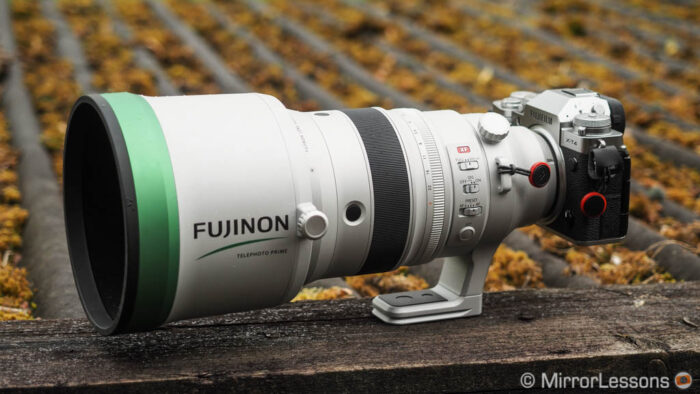
AF score
81%
96%
Lenses used: XF 100-400mm F4.5-5.6, XF 200mm F2 (+ TC 1.4x), XF 70-300mm F4-5.6
Number of images taken: 6,700
Firmware version when last tested for BIF: 1.23
Drive score (20fps)
81%
16 / 20
Drive score (30fps)
79%
23 / 30
I was eager to test the X-T4 and its updated autofocus algorithm. According to Fujifilm, the camera can analyse color and shape data in addition to distance data, and the success rate should be two times better in comparison to its predecessor the X-T3.
My tests showed that there is indeed an improvement, but I wouldn’t say that it is 2x better. Like the X-T3, the settings you choose can drastically influence the results. The best score I got was using the inexpensive 70-300mm, and the superb and very expensive XF 200mm f2 prime lens. The 100-400mm is on the same level.
Using the electronic shutter with a blackout-free live view is great for following the birds, and the camera has plenty of burst speeds to capture the most difficult moments (including a Pre-Shot mode). Note that the buffer is limited when selecting the fastest speeds.
The best Fuji X-T4 settings for birds in flight:
- Focus Area: Zone 7×7
- Focus Priority
- AF-C Custom Settings: Set 6 (0, 2, Front)
- Drive Mode: 20fps with electronic shutter, 10 to 30fps with e-shutter and 1.25x crop
As for everything else, the X-T4 is very similar to the X-T3: a 26.1MP APS-C sensor, good EVF, weather-sealing and two SD card slots. The ergonomics without an optional grip remain limited when using large lenses but the battery life has improved thanks to the new unit. After more than 4000 shots, I still had two bars left out of five.
Reminder: the links below are affiliate links. If you decided to buy something after clicking the link, we will receive a small commission.
Additional content:
Canon EOS R7
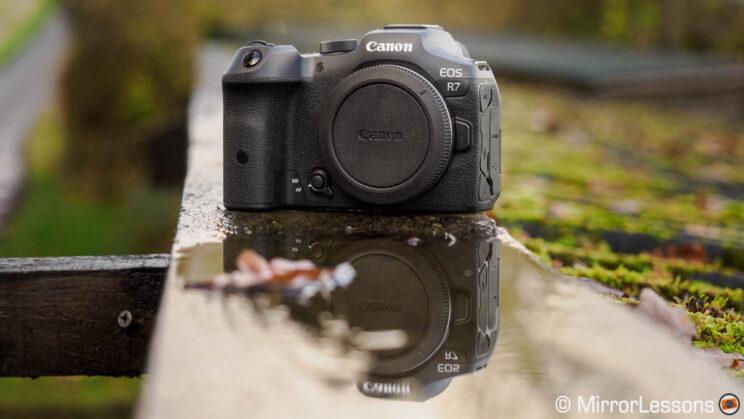
AF score
80%
93%
Lens Lenses used: RF 100-500mm F4.5-7.1L IS USM, RF 100-400mm F5.6-8 IS STM
Number of images taken: 3,757
Firmware version when last tested for BIF: 1.1.0
Drive score (30fps)
80%
24 / 30
Drive score (15fps)
70%
10 / 15
The Canon R7 piqued my interest when announced, blending very promising specs and performance with a competitive price. Unfortunately, it showed severe limitations in the field.
The most important thing to be aware of is the invasive rolling shutter when using the electronic shutter, which is the mode that gives you the attractive 30fps drive speed. The sensor readout is simply not fast enough for fast moving subjects. Expect distortion in the background, and likely on the bird itself.
The autofocus performance is very good in other instances, but my birds in flight test showed the R7 is not on par with its full frame siblings. It focuses on the background more times than you’d like, and often struggles to correct focus quickly in the middle of a sequence. The AF score above is not bad, but keep in mind that there is also inconsistency in the performance. I experienced worse results (72% – 75%) with the same settings and lens on the second day of shooting.
The best Canon EOS R7 settings for birds in flight:
- AF Zone: Flexible Zone 1 (custom medium size)
- Start / Stop Tracking: off
- Subject Tracking: on
- Subject to Detect: Animals
- Eye Detection: Enable
- Switching tracked subjects: 0
- Servo AF: Case Auto
- Lens drive when AF impossible: on
- Drive: 15fps (mechanical shutter), 30fps (electronic shutter – Beware of Rolling Shutter!)
- Stabilisation: Off
The APS-C crop factor coupled with the excellent resolution of 32.5MP can give you a lot of flexibility, and overall the image quality is good. You get weather sealing, two SD card slots, an excellent battery life and good ergonomics, although I have to take one star off on the last point because of the weird joystick/dial combination on the rear. There was great potential, but the R7 is not the best APS-C camera for this genre.
Reminder: the links below are affiliate links. If you decided to buy something after clicking the link, we will receive a small commission.
Sony A6400
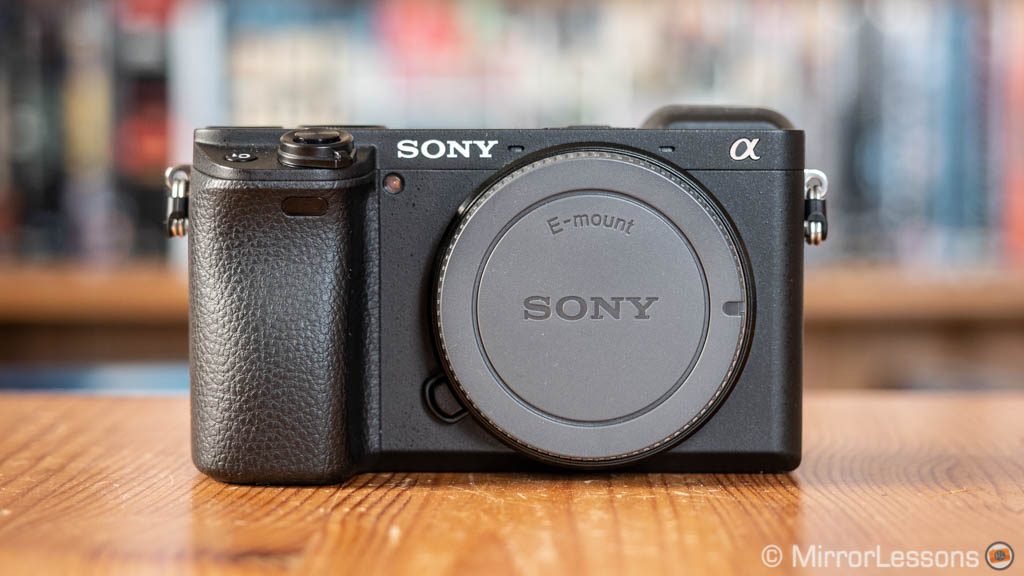
AF score
80%
93%
Lens used: FE 100-400mm F4.5-5.6 GM
Number of images taken: 290
Firmware version when last tested for BIF: 1.00
Drive score (8fps)
80%
6 / 8
Drive score (10fps)
77%
7 / 10
Note: Version 2.0 added Eye AF for Animals, but it doesn’t work with birds.
It was an ideal sunny day to photograph the kites and, being already familiar with Sony settings, I didn’t need to prep the camera or test anything in particular. The autofocus proved to be really good and I can’t say I’m surprised. The A6300 and A6500 did well before, and the software improvements brought to the A6400 did the rest. Real-time tracking works well but is not quite as realiable as the Zone area, unlike more expensive full frame E-mount cameras.
The best Sony A6400 settings for birds in flight:
- Focus Area: Zone
- Priority Setting in AF-C: Focus
- Drive Mode: Hi (8fps)
The A6400 has a fast continuous shooting speed of 10fps, but I prefer to use the setting below (8fps) because I get live view (with blackouts) in the EVF. Live view is important because kites can change direction at any moment and you need to react quickly. The 24MP APS-C sensor delivers excellent image quality, but the overall ergonomics of the camera is not great and the battery life is limited.
Reminder: the links below are affiliate links. If you decided to buy something after clicking the link, we will receive a small commission.
Fujifilm X-H2
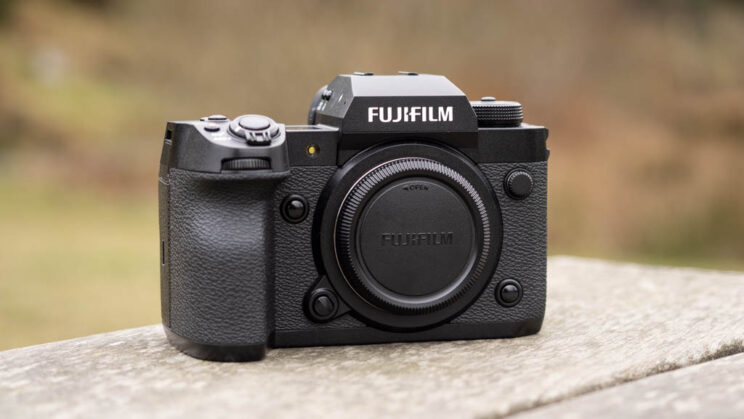
AF score
78%
95%
Lens used: XF 150-600mm f/5.6-8 R LM OIS WR
Number of images taken: 2,132
Firmware version when last tested for BIF: 1.21
Drive score (15fps)
76%
11 / 15
Drive score (20fps)
78%
16 / 20
Like its sibling the X-H2S, the X-H2 offers decent performance but remains inferior to the likes of Canon, Nikon and Sony. For static subjects, such as birds perched on tree branches, it is actually quite good. Focus is precise on the eye of the bird, and it can be detected even when the animal is small inside the frame, or partially covered by natural elements. And that is valid for video as well!
But just like the S model, it struggles with fast moving birds, with the autofocus often switching to the background, or failing to lock onto the bird to begin with. I tried many setting combinations, and the ones below gave me the best results. Note that it is better to leave subject detection off for birds in flight, whereas it is very useful for static animals.
The sensor readout is not as fast as the X-H2S, so you have to be careful with rolling shutter. The maximum speed is 20fps (with a 1.29x crop, so a 24MP file), or 15fps when using the mechanical shutter. The buffer is very good with an SD and CFexpress card.
The best Fuji X-H2 settings for birds in flight:
- Focus Area: Zone 7×7
- Focus Priority
- AF-C Custom Settings: Set 6 (4, 2, Center)
- Subject Detection: Off
- Performance: Boost 120fps
- Drive Mode: 20fps (crop) with electronic shutter, or 15fps with mechanical shutter
The X-H2 features a 40MP sensor, the highest resolution currently available on an APS-C camera, and the image quality is really good, with a small tradeoff at high ISOs in comparison to the 26MP sensor of the X-H2S. It offers 8K video up to 30p, with 10-bit internal recording, The ergonomics and build quality are very good, with nice controls and lots of customisation. You also get a decent battery life and an excellent viewfinder.
Reminder: the links below are affiliate links. If you decided to buy something after clicking the link, we will receive a small commission.
Fujifilm X-S10
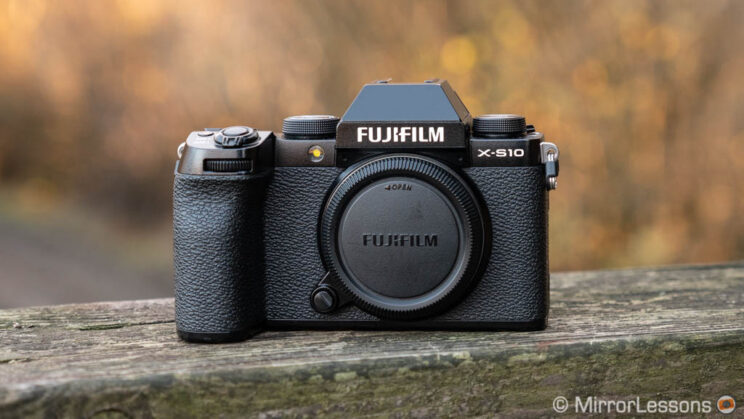
AF score
78%
94%
Lens used: XF 70-300mm f/4-5.6 R LM OIS WR
Number of images taken: 750
Firmware version when last tested for BIF: 2.10
Drive score (10fps)
78%
7 / 10
Drive score (30fps)
71%
21 / 30
The X-S10 features the same autofocus system and drive speed as the X-T4, including the same software algorithm and locking speed, so I was not surprised to see similar results to the flagship APS-C camera. I only tested it with the 70-300mm, which is a perfect fit thanks to the small dimensions. In total, the combo weighs around 1kg.
The best Fuji X-S10 settings for birds in flight:
- Focus Area: Zone 7×7
- Focus Priority
- AF-C Custom Settings: Set 6 (0, 2, Front)
- Drive Mode: 10fps/30fps with electronic shutter and 1.25x crop
The X-S10 also shares the same 26MP BSI sensor as the X-T4, but the body is not weather-sealed, the viewfinder is smaller, there is only one card slot and the battery is older. The advantage is the larger front grip, which makes the camera more comfortable to hold. It’s a shame that some of the buttons are too small.
Reminder: the links below are affiliate links. If you decided to buy something after clicking the link, we will receive a small commission.
Olympus OM-D E-M1X
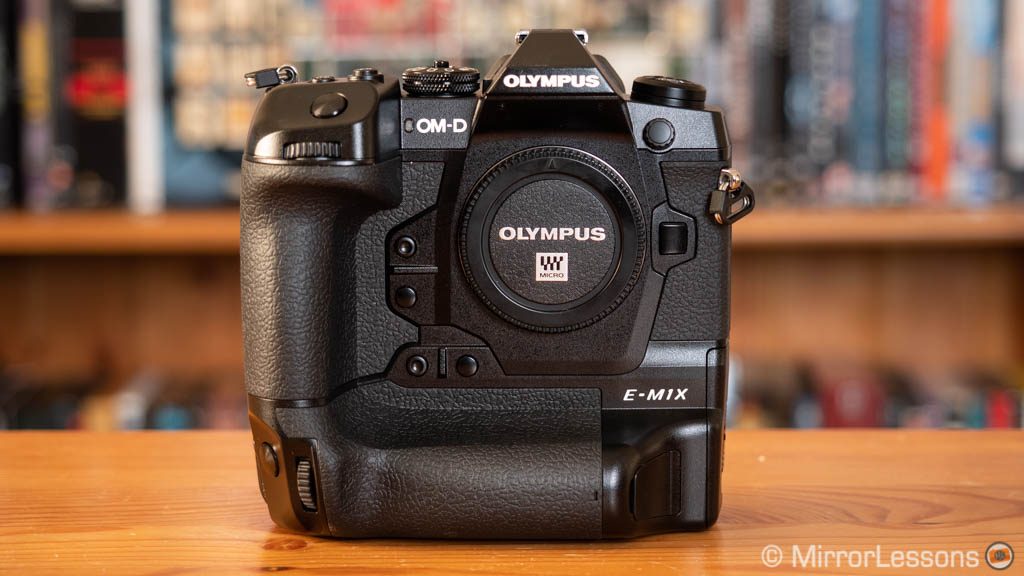
AF score
74%
91%
Lens used: M.Zuiko 300mm F4 Pro, M.Zuiko 150-400mm F4.5 Pro
Number of images taken: 1,296
Firmware version when last tested for BIF: 2.00
Drive score (18fps)
74%
13 / 18
Note: firmware 2.3 mentions ‘Improved precision of focus when using single-focal-length lenses’.
The important thing to know about the E-M1X is that an AF Target other than the 5×5 grid can lower the score quite significantly. As for everything else, it is the camera that finally gave the OM-D range a decent autofocus performance for this genre.
Firmware 2.0 added Bird Subject Detection, but I didn’t find it to give the camera a boost in performance when it comes to birds in flight. It is more useful for static or slow moving subjects.
The best OM-D E-M1X settings for birds in flight:
- AF-Target Mode: 25-Target Group (5×5)
- Release Priority: Focus
- AF Sensitivity: +2
- AF Scanner: Mode 3
- Drive Mode: Continuous Low with electronic shutter (18fps)
The E-M1X is one of the only mirrorless camera with an integrated vertical grip. It is built like a tank, is very comfortable to hold and has a superb battery life. The high speed continuous shooting (up to 60fps) and special features such as Pro Capture are great for bird photographers. And while the body is rather large for a four thirds sensor, remember that the lenses remain compact.
Reminder: the links below are affiliate links. If you decided to buy something after clicking the link, we will receive a small commission.
Nikon Z50
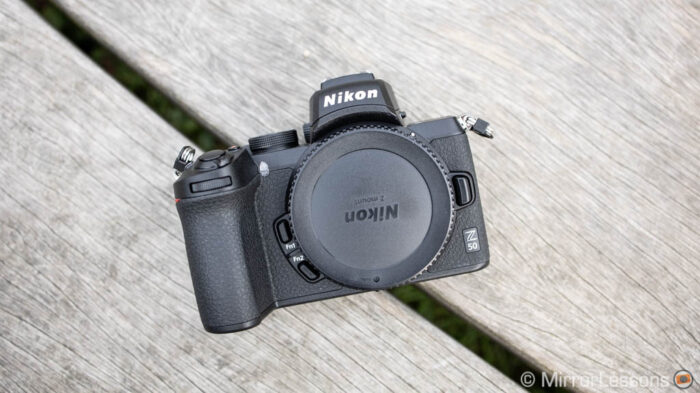
AF score
74%
87%
Lens used: AF-S NIKKOR 300mm F4 PF and TC 1.4x III
Number of images taken: 1,080
Firmware version when last tested for BIF: 2.01
Drive score (5fps)
74%
3 / 5
Drive score (11fps)
69%
7 / 11
The Z50 showed better performance than expected. There isn’t a lot to configure to get the best results, and its Auto-Area AF mode is more reliable than the one found on the Z6 (although I still advice to use the Wide-area L option). The autofocus was a bit slower when I tested the camera with the TC 2.0 III but, with the teleconverter 1.4x and the compact 300mm f4 PF, it is one of the most interesting setup in this article.
The best Nikon Z50 settings for birds in flight:
- Focus Area: Wide-area (L)
- Priority Setting in AF-C: Focus
- Drive Mode: H 5fps
The Z50 is a mid-range camera, so there are a few things experienced photographer might like a dual card slot, UHS-II support and a larger viewfinder. The grip is good despite the camera the compact dimensions, and there is weather sealing, although not as advanced as that of the Z6. The fastest burst speed is 11fps, but the buffer is not great.
Reminder: the links below are affiliate links. If you decided to buy something after clicking the link, we will receive a small commission.
Additional content:
Sony A6500
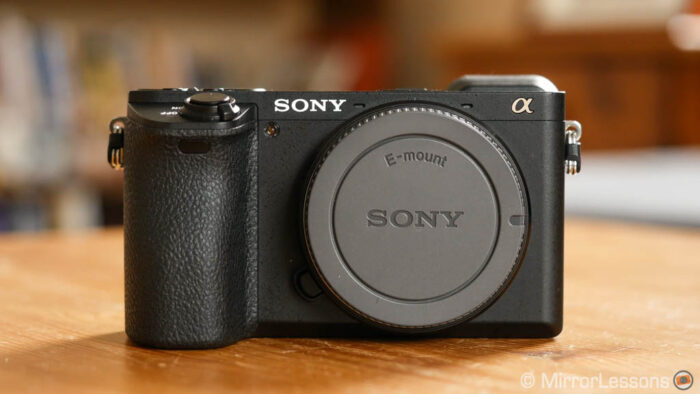
AF score
73%
97%
Lens used: FE 70-300 F4.5-5.6 G OSS
Number of images taken: 138
Firmware version when last tested for BIF: 1.02
Drive score (8fps)
73%
5 / 8
Drive score (10fps)
n.a.
n.a.
Note: bad weather and me arriving late at the station limited the amount of time I had to test the camera. This is why there isn’t data for the 10fps burst. However, I suspect the score would be similar to 8fps, as with many other Sony cameras.
The kites didn’t stay around for too long so I didn’t take a lot of pictures. The 70-300mm proved to be a bit short as well. Concerning the performance though, there is nothing special to declare. It does the job well, without the need to fuss with settings more than the strictly necessary.
The best Sony A6500 settings for birds in flight:
- Focus Area: Zone
- Priority Setting in AF-C: Focus
- Drive Mode: Hi 8fps
The A6500 shares many similarities with the A6400 including the fastest burst speed of 10fps and the 24MP APS-C sensor. The AF performance was a tad below, perhaps because of the lens, or simply because the AF algorithm is not exactly the same. The overall ergonomics and the poor battery life are its weak points. The viewfinder is a bit small as well.
Reminder: the links below are affiliate links. If you decided to buy something after clicking the link, we will receive a small commission.
Fujifilm X-T3

AF score
72%
96%
Lens used: XF 100-400mm F4.5-5.6
Number of images taken: 1,034
Firmware version when last tested for BIF: 3.10
Drive score (20fps)
72%
14 / 20
Drive score (30fps)
69%
20 / 30
Note: firmware 4.0 gives the X-T3 the same algorithm and 0.02s locking speed as the X-T4. Therefor, the score should be theoratically more similar to 81% / 96%.
The X-T3 has a fast sensor readout that allows you to shoot up to 20fps with live view and no blackouts by using the electronic shutter, just like the Sony A9. The clear and uninterrupted live view really helps for birds in flight. Like Olympus cameras, picking the right setting is paramount.
The best Fujifilm X-T3 settings for birds in flight:
- AF Mode: Zone (7×7)
- AF-C Custom Settings: Set 4
- AF-C Priority Selection: Focus
- Drive Setting: CH 20fps with electronic shutter
- Power Management / Performance: Boost
The X-T3 has a 26.1MP APS-C sensor that offers good image quality. You can also shoot with a 1.25x crop to get extra reach (16MP output). The battery life is not exceptional but there is an official battery grip available. The viewfinder is really good, the camera is completely weather-sealed and there are two SD card slots. The ergonomics are not the best with large lenses such as the XF 100-400mm, but the vertical grip or an optional grip extender can help.
Reminder: the links below are affiliate links. If you decided to buy something after clicking the link, we will receive a small commission.
Olympus OM-D E-M1 III
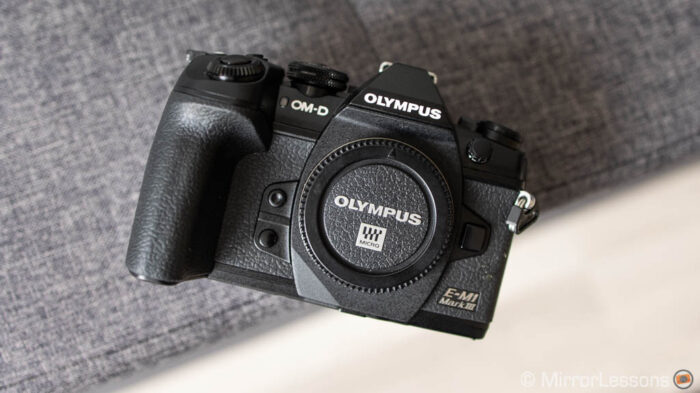
AF score
72%
94%
Lens used: M.Zuiko ED 300mm f4 Pro IS, MC-14
Number of images taken: 1,655
Firmware version when last tested for BIF: 1.1
Drive score (18fps)
72%
13 / 18
Note: with the MC-14 teleconverter, the performance decreases (59% / 88%).
The E-M1 III inherits the same autofocus system as the flagship E-M1X (except for Intelligent Subject Detection). So it’s not surprising to see a similar performance and keeper rate. The tips to get the best result remain the same concerning the AF Target mode (use the 25-Target group). The L burst with the electronic shutter is also better than the one with the mechanical shutter.
The best OM-D E-M1 III settings for birds in flight:
- AF-Target Mode: 25-Target Group (5×5)
- Release Priority: Focus
- AF Sensitivity: +2
- AF Scanner: Mode 3
- Drive Mode: Continuous Low with electronic shutter (18fps)
The E-M1 III is very similar to the mark II concerning other specs. You get the same excellent battery life, two SD card slots (although only one is UHS-II compatible), Pro Capture (up to 60fps), a well designed body that is very ergonomics and solid. You have the advantage of a compact system and lots of choice when it comes to lenses.
Reminder: the links below are affiliate links. If you decided to buy something after clicking the link, we will receive a small commission.
Olympus OM-D E-M5 III
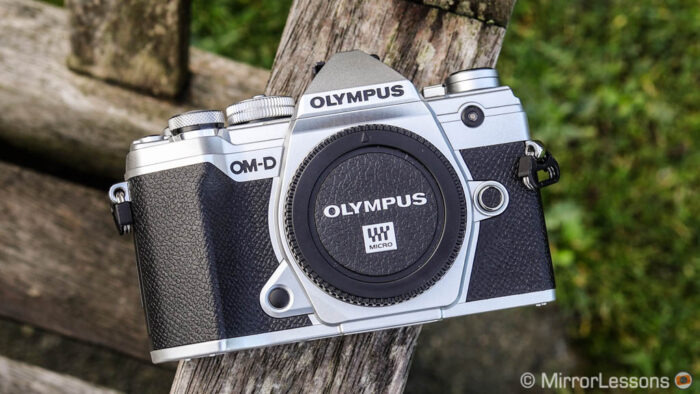
AF score
72%
93%
Lens used: M.Zuiko ED 300mm f4 Pro IS
Number of images taken: 833
Firmware version when last tested for BIF: 1.0
Drive score (10fps)
72%
7 / 10
Note: firmware 1.6 adds an improvement with AF and prime lenses.
The E-M5 III inherits the AF system of the flagship E-M1X, so it is not surprising to see a similar score with the smaller camera. As with the other OM-D models, choosing the correct settings is important to get the best performance, especially when it comes to the AF Target.
The best OM-D E-M5 III settings for birds in flight:
- AF-Target Mode: 25-Target Group (5×5)
- Release Priority: Focus
- AF Sensitivity: +2
- AF Scanner: Mode 3
- Drive Mode: Continuous Low with electronic shutter (10fps)
The E-M5 III lacks a large grip, a dedicated battery grip, a bigger battery and dual card slots, which make it less compelling than other cameras for this specific genre. The continuous shooting speed goes up to 30fps but you lose continuous AF. It does retain interesting functions for birds such as Pro Capture, and comes with weather-sealing despite the plastic build.
Reminder: the links below are affiliate links. If you decided to buy something after clicking the link, we will receive a small commission.
Check the price of the Olympus OM-D E-M5 III on
Amazon | B&H Photo | eBay
Sony A7R III / A7R IIIA
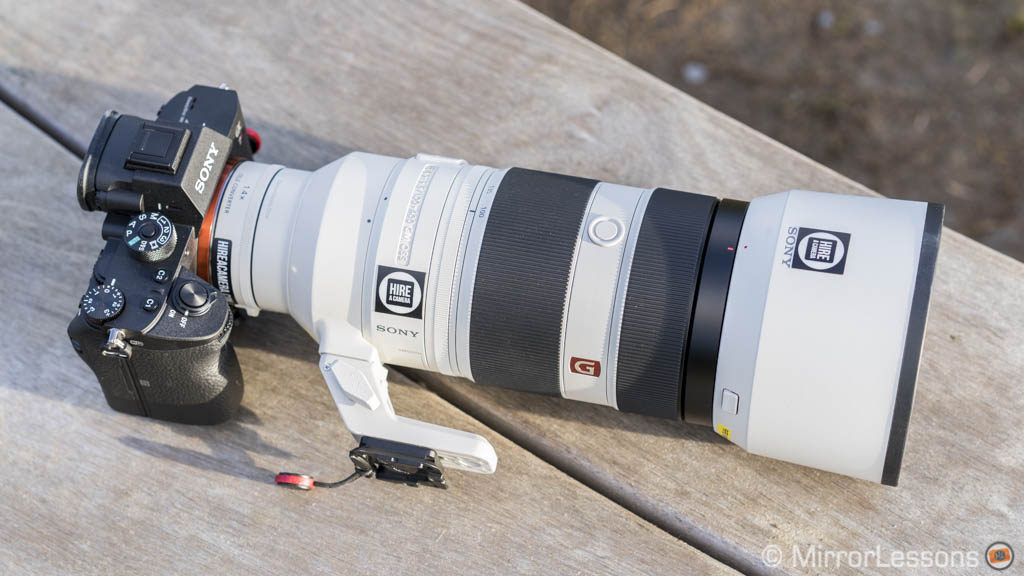
AF score
71%
97%
Lenses used: FE 100-400mm f4.5-5.6 GM OSS + TC 1.4x, FE 200-600mm F5.6-6.3 G OSS
Number of images taken: 400
Firmware version when last tested for BIF: 3.20
Drive score (10fps)
71%
6 / 10
The first time I tested the A7R III for BIF was not the best weather-wise (dark clouds and not a lot of light), and I was also using a lens with a TC 1.4x attached, so perhaps the score was somewhat penalised (62%/88%). A few years later, with the latest firmware and the excellent 200-600mm zoom, the performance was better. Note that phase detection works up to f/8 in continuous mode. With smaller apertures, focus is locked on the first frame (except for the Low burst of 3fps).
The best Sony A7R III settings for birds in flight:
- Focus Area: Zone
- Priority Setting in AF-C: Focus
- AF Track Sensitivity: 5 (Responsive)
- Drive Mode: Hi (8fps) or Hi+ (10fps)
The A7R III features an excellent 42MP BSI full frame sensor. If you use it in APS-C crop to benefit from the extra reach, you still get 18MP which is not bad at all. The design is the same as the A9 and A7 III: dual memory card slot, long lasting battery and weather-sealing but not perfect ergonomics. The viewfinder has more resolution and a faster refresh rate than the A7 III however. The burst speed goes up to 10fps but once again I prefer 8fps to have live view (and a bit more buffer given the large files).
Reminder: the links below are affiliate links. If you decided to buy something after clicking the link, we will receive a small commission.
Additional content:
Olympus OM-D E-M1 II
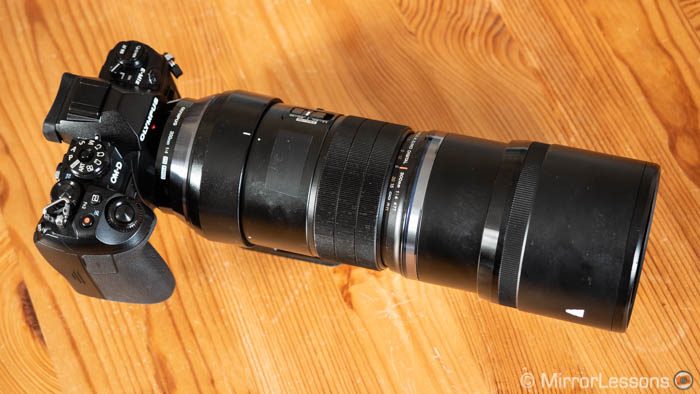
AF score
66%
81%
Lenses used: M.Zuiko 300mm F4 Pro, Leica DG 100-400mm F4-6.3
Number of images taken: 816
Firmware version when last tested for BIF: 3.0
Drive score (18fps)
66%
12 / 18
Note: possible improvement with the AF and prime lenses when firmware 3.6 is installed.
Performance is consistent with the two lenses.
The E-M1 II received a significant boost in AF performance with firmware 3.0, inheriting some of the flagship E-M1X’s algorithm. This made the score jump from 43% to 66% (green percentage). This is also thanks to the 5×5 Target area that, just like on the E-M1X, is the best setting for birds in flight. Using the fastest burst with the electronic shutter also helps.
The best OM-D E-M1 II settings for birds in flight:
- AF Target: 5×5
- Release Priority: Focus
- AF Sensitivity: +2
- AF Scanner: Mode 3
- Drive Mode: Continuous Low with electronic shutter (18fps)
The E-M1 II is an excellent camera for many reasons: it is compact yet features a very comfortable grip (one of my all times favourites), so holding the camera with a large lens is not a problem, even without the battery grip. The battery life is excellent and there are tons of features that can be useful for bird photography such as Pro Capture.
Reminder: the links below are affiliate links. If you decided to buy something after clicking the link, we will receive a small commission.
Check price of the Olympus OM-D E-M1 II on
Amazon | Amazon UK | eBay | B&H Photo
Additional content:
Fujifilm X-T2
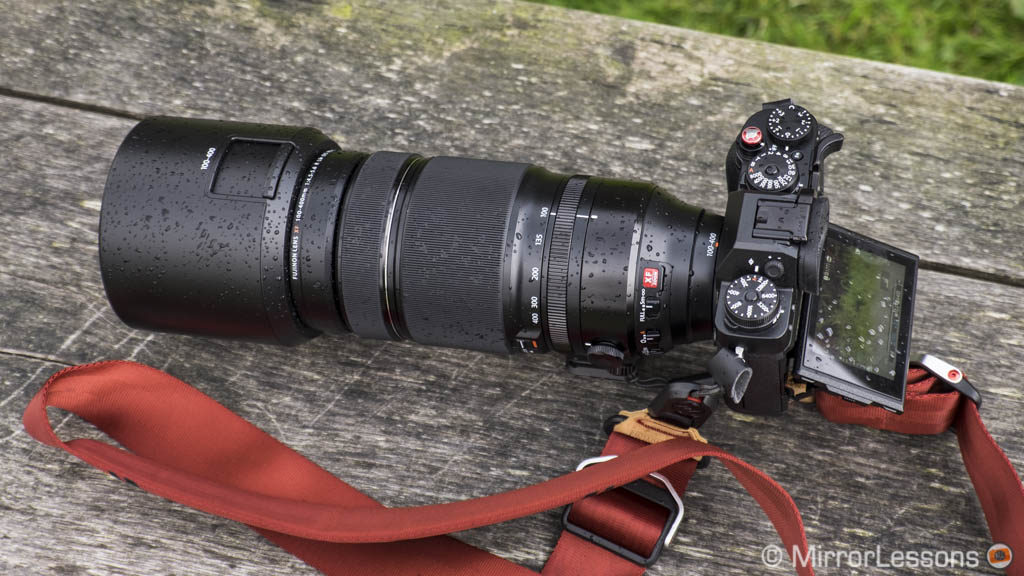
AF score
63%
87%
Lens used: XF 100-400mm F4.5-5.6
Number of images taken: 1,103
Firmware version when last tested for BIF: 1.00
Drive score (8fps)
63%
5 / 8
Note: firmware 4.10 added an updated AF algorithm to improve the tracking of animals and detect their texture better. I tested this update via the X-H1 (same software), but the results were pretty much the same.
The X-T2 proved to be a good step up from the previous X-T1 thanks to the larger number of phase detection points covering the sensor, better focus areas to choose from and a larger buffer. The improvement for birds was quite significantly, making the camera more reactive and increasing the keeper rate. It is important to select the correct settings, otherwise the performance can decrease significantly.
The best Fujifilm X-T2 settings for birds in flight:
- AF Mode: Zone (7×7)
- AF-C Custom Settings: Set 4
- AF-C Priority Selection: Focus
- Drive Setting: CH 8fps
- Power Management / Performance: Boost
The highest burst available, CH (8fps) doesn’t give you live view but at the time I made an effort to use it to get a faster speed which always helps with the kites. You can increase the speed to 11fps with the optional battery grip. The EVF refresh rate goes up to 100fps in Boost mode. The 24MP APS-C sensor gives you the same quality as the X-T3 (if not even slightly better at high ISOs). There is weather-sealing, two SD card slots but you will most certainly need an extra grip for better comfort.
Reminder: the links below are affiliate links. If you decided to buy something after clicking the link, we will receive a small commission.
Check price of the Fujifilm X-T2 on
Amazon | Amazon UK | B&H Photo | eBay
Fujifilm X-H1
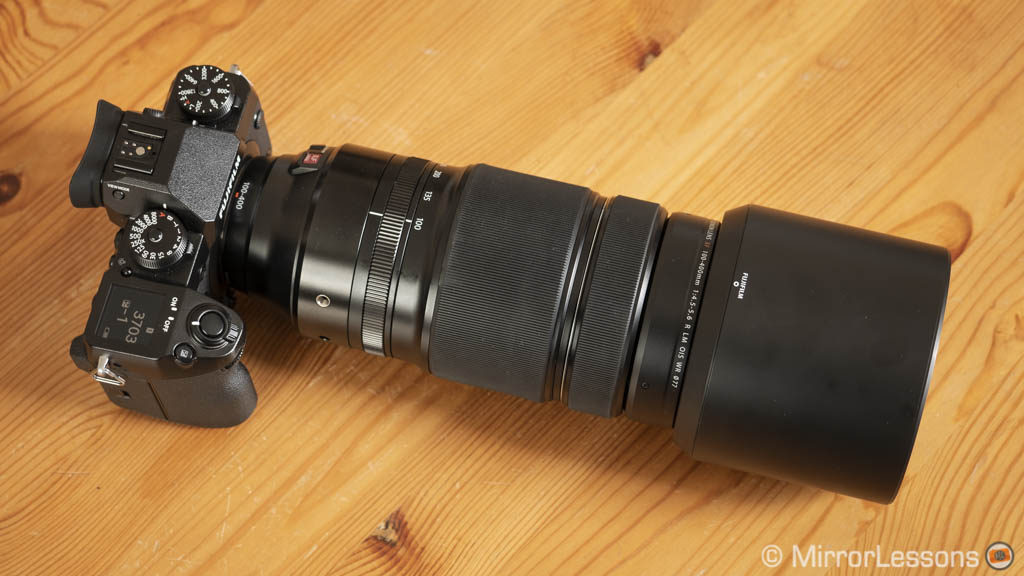
AF score
62%
83%
Lens used: XF 100-400mm F4.5-5.6
Number of images taken: 1,044
Firmware version when last tested for BIF: 1.00
Drive score (8fps)
62%
5 / 8
The X-H1 features the same AF system as the X-T2 so it is not surprising that the performance is very similar. At times, it can be a bit slow in locking onto the bird when it moves fast, or a bit slow to re-adjust the focus when the sequence doesn’t start in focus. Otherwise, the performance is rather good but you need to make sure to have the correct settings.
The best Fujifilm X-H1 settings for birds in flight:
- AF Mode: Zone (7×7)
- AF-C Custom Settings: Set 4
- AF-C Priority Selection: Focus
- Drive Setting: CH 8fps
- Power Management / Performance: Boost
The high price of the X-H1 and some missed opportunities (better battery life) that could have made it better than the X-T range didn’t convince many photographers to switch, despite the larger and more comfortable grip. Significant discounts in the second half of 2019 have given the camera a second life. Like the X-T2 and X-T3, you get weather-sealing and two SD card slots. The EVF is also good with a resolution of 3.69M dots and a refresh rate of 100fps.
Reminder: the links below are affiliate links. If you decided to buy something after clicking the link, we will receive a small commission.
Check price of the Fujifilm X-H1 on
Amazon | Amazon UK | eBay | B&H Photo
Panasonic G9
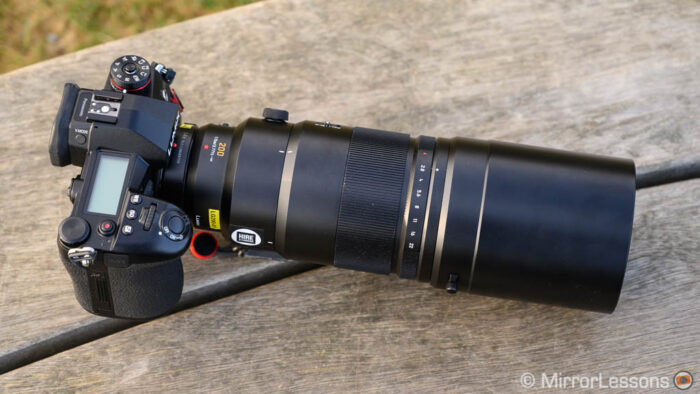
AF score
57%
70%
Lenses used: Leica DG Elmarit 200mm F2.8 Power OIS, Leica DG 100-400mm F4-6.3 OIS
Number of images taken in the last test: 2,392
Firmware version when last tested for BIF: 2.4
Drive score (9fps)
57%
5 / 9
Drive score (20fps)
38%
7 / 20
The G9 is the camera that gave the most disparate results depending on the specific settings or background. With the kite against blue sky using the mechanical shutter, I got a score of 78% / 94%. Choose the fast burst of 20fps with the electronic shutter and the bird against trees, and the score dropped as low as 21% / 32%. Thankfully, the latest firmware has improved the results when the animal is against a busy background.
The best Panasonic G9 settings for birds in flight:
- Auto Focus Mode: Animal Detection with 1-Area (largest)
- AF Custom Settings: AF Sensitivity +1, AF Area Switching Sensitivity +1, Moving Object Prediction +1
- Focus / Release Priority: Focus
- AE/AF Lock: AF-ON Near Shift
- Drive Setting: High 9fps (mechanical shutter)
In all my other tests, the G9 did admirably well, outranking the OM-D cameras and proving to be as good as some of the best Sony models. The design is superb, the EVF is truly one of the best out there (also thanks to the selectable magnification), but the challenge that a bird in flight can present is too much for the DfD contrast detection AF to cope with.
Reminder: the links below are affiliate links. If you decided to buy something after clicking the link, we will receive a small commission.
Additional content:
Summary and Rankings
Here are two lists with all the results, starting with the AF score.
Remember that the AF Score doesn’t necessarily represents the hit rate at the fastest burst speed. For example, if a camera can work at 30fps but the keeper rate is higher at 20fps, the AF Score will show the result taken at 20fps. It’s purely an indication of the autofocus performance for each camera.
AF Score
Sony A1
98%
100%
Nikon Z8 / Z9
96%
100%
Sony A9 / A9 II
96%
99%
Canon EOS R3
94%
100%
Sony A7 IV
94%
99%
Canon EOS R6 II
93%
99%
Canon EOS R8
93%
99%
Canon EOS R6
93%
97%
Nikon Z7 II
91%
98%
Canon EOS R5
90%
99%
OM System OM-1
89%
98%
Sony A7R IV
88%
100%
Nikon Z7*
88%
96%
Sony A7 III
86%
99%
Nikon Z6
86%
95%
Sony A6600
85%
98%
Sony A7R V
84%
97%
Panasonic S5 II
83%
96%
Fujifilm X-H2S
82%
97%
Panasonic G9 II
82%
96%
Fujifilm X-T4
81%
96%
Canon EOS R7
80%
93%
Sony A6400
80%
93%
Fujifilm X-H2
78%
95%
Fujifilm X-S10
78%
94%
Olympus E-M1X
74%
91%
Nikon Z50
74%
87%
Sony A6500
73%
97%
Fujifilm X-T3
72%
96%
Olympus E-M1 III
72%
94%
Olympus E-M5 III
72%
93%
Sony A7R III
71%
97%
Olympus E-M1 II
66%
81%
Fujifilm X-T2
63%
87%
Fujifilm X-H1
62%
83%
Panasonic G9
57%
70%
Note: the Z7 score was obtained with the Z 70-200mm F2.8 and TC 1.4x, which is a shorter focal length compared to the lenses used with the other cameras.
Then we have the Drive Score ranking, which represents how many good photos (in focus) each camera can give you at its fastest continuous shooting speed. Remember that to keep things simple, I’ve only taken into account the green percentage in this case.
It is interesting to note how the order of some cameras changes drammatically. Please refer to the chapters at the beginning of the article where I explain with more details the difference between the two rankings.
Drive Score
Nikon Z8 / Z9*
96%
115/120
Panasonic G9 II
82%
49/60
OM System OM-1
85%
42/50
Canon EOS R6 II
93%
37/40
Canon EOS R8
93%
37/40
Fujifilm X-H2S
82%
33/40
Sony A1
94%
28/30
Canon EOS R3
94%
28/30
Canon EOS R7
80%
24/30
Fujifilm X-T4
79%
23/30
Panasonic S5 II
71%
21/30
Fujifilm X-S10
71%
21/30
Fujifilm X-T3
69%
20/30
Sony A9 / A9 II
96%
19/20
Canon EOS R6
93%
18/20
Canon EOS R5
90%
18/20
Fujifilm X-H2
78%
16/20
Olympus E-M1X
74%
13/18
Olympus E-M1 III
72%
13/18
Olympus E-M1 II
66%
12/18
Nikon Z6
82%
9/12
Sony A7 IV
94%
9/10
Sony A7R IV
88%
8/10
Sony A7 III
86%
8/10
Sony A6600
85%
8/10
Sony A7R V
84%
8/10
Panasonic G9
38%
7/20
Nikon Z50
69%
7/11
Nikon Z7 II
77%
7/10
Sony A6400
77%
7/10
Olympus E-M5 III
72%
7/10
Sony A7R III
71%
7/10
Nikon Z7
82%
7/9
Sony A6500*
73%*
5/8*
Fujifilm X-T2
63%
5/8
Fujifilm X-H1
62%
5/8
*Note: The Nikon Z8 and Z9 work at 120fps in JPG only, and with a 11MP output. The A6500 can work at 10fps but I only have the results for 8fps.
It goes without saying, but the two rankings above focus on autofocus and speed only. They don’t tell you the full story. When it comes to birds and wildlife in general, there are other things to consider such as the cost, the size, the sensor, the lenses, the ergonomics and extra features that can be useful when taking pictures of animals. Please refer to the description of each camera throughout this article to learn more about them.
Additional Resources
Below you can find additional articles about mirrorless cameras, birds in flight and wildlife photography.
- Best Mirrorless Cameras for Wildlife Photography
- Sony A1 and Bird Photography
- Wildlife and Birds with Sony A7 / A9 – Guide
- Canon R5 / R6 Settings for Wildlife and Birds – Guide
- E-M1 II / E-M1X Settings for Birds – Guide
- Panasonic G9 Settings for Birds – Guide
- Fujifilm X-T4 Settings for Birds in Flight – Guide
- Nikon Z50 / Z6, 300mm F4 PF and Birds in Flight

